 |
|
HOME
|
US Navy -
ships
|
US Navy - air
units
|
USMC - air
units
|
International
Navies
|
Weapon Systems
|
Special Reports |
|
|
|
|
|
Royal Navy / Fleet Air Arm Sea Harrier FRS.1 + FA.2 |
|
|
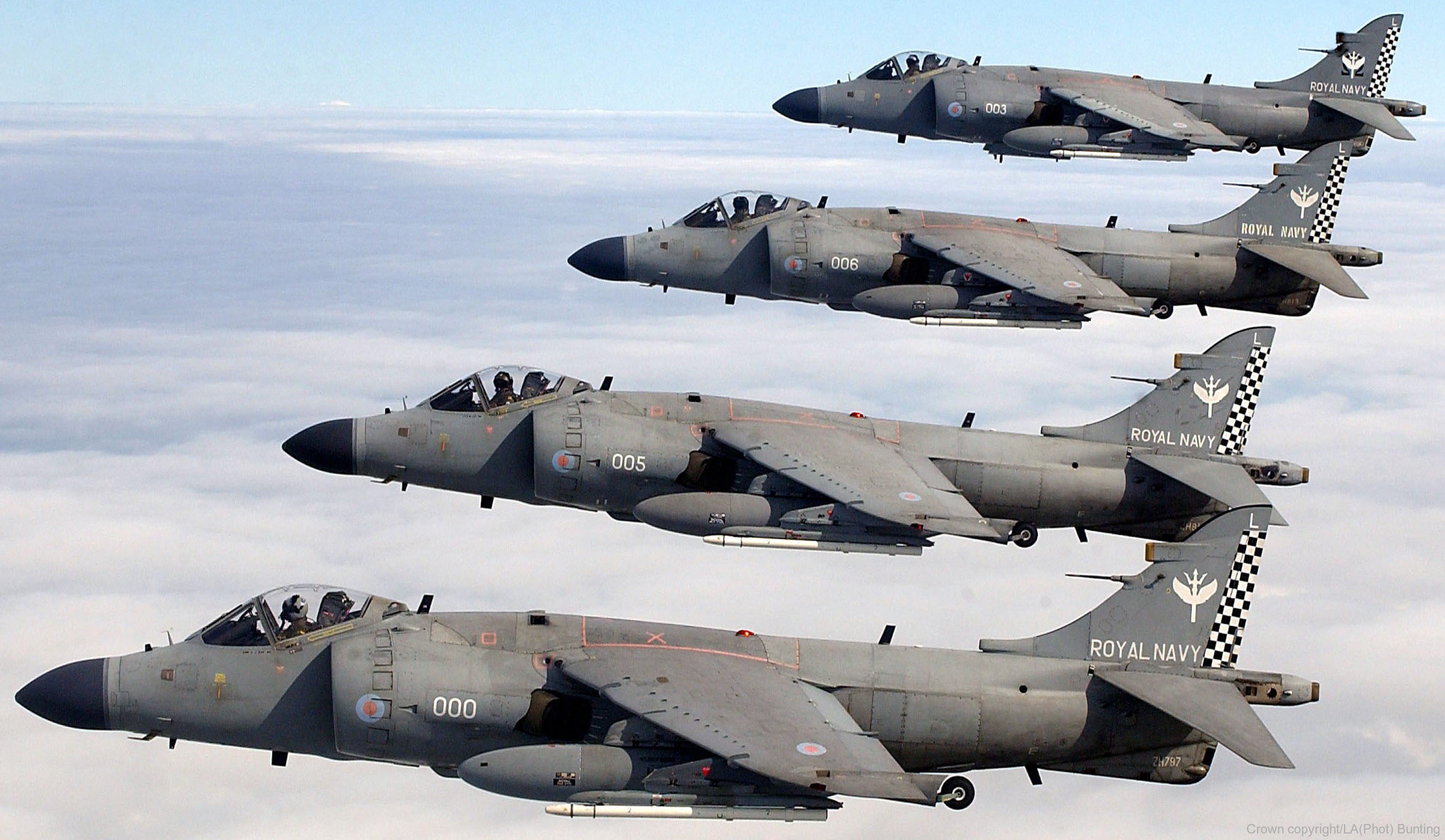 |
|
|
|
The British Aerospace Sea Harrier is a
naval short take-off and vertical landing/vertical take-off and
landing jet fighter, reconnaissance and attack aircraft; the second
member of the Harrier Jump Jet family developed. It first entered
service with the Royal Navy in April 1980 as the Sea Harrier FRS1
and became informally known as the "Shar". Unusual in an era in
which most naval and land-based air superiority fighters were large
and supersonic, the principal role of the subsonic Sea Harrier was
to provide air defence for Royal Navy task groups centred around the
aircraft carriers. The Sea Harrier served in the Falklands War and the Balkans conflicts; on all occasions it mainly operated from aircraft carriers positioned within the conflict zone. Its usage in the Falklands War was its most high profile and important success, when it was the only fixed-wing fighter available to protect the British Task Force. The Sea Harriers shot down 20 enemy aircraft during the conflict; 2 Sea Harriers were lost to enemy ground fire. They were also used to launch ground attacks in the same manner as the Harriers operated by the Royal Air Force. The Sea Harrier was marketed for sales abroad, but by 1983 India was the only operator other than Britain after attempts to sell the aircraft to Argentina and Australia were unsuccessful.[3][4] A second, updated version for the Royal Navy was made in 1993 as the Sea Harrier FA2, improving its air-to-air abilities and weapons compatibilities, along with a more powerful engine; this version continued manufacture until 1998. The aircraft was withdrawn from service early by the Royal Navy in 2006. The Sea Harrier remained in service for a further decade with the Indian Navy until its retirement in 2016. Development: In the post-World War II era, the Royal Navy began contracting in size as the break-up of the British Empire overseas and the emergence of the Commonwealth of Nations reduced the need for a large navy. By 1960, the last battleship, HMS Vanguard, was retired from the Navy, having been in service for less than fifteen years. In 1966 the planned CVA-01 class of large aircraft carriers destined for the Royal Navy was cancelled. During this time, requirements within the Royal Navy began to form for a vertical and/or short take-off and landing (V/STOL) carrier-based interceptor to replace the de Havilland Sea Vixen. The first V/STOL tests on a ship began with a Hawker Siddeley P.1127 landing on HMS Ark Royal in 1963. A second concept for the future of naval aviation emerged in the early 1970s when the first of a new class of "through deck cruisers" was planned. These were very carefully and politically designated as cruisers to deliberately avoid the term "aircraft carrier", in order to increase the chances of funding from a hostile political climate against expensive capital ships, they were considerably smaller than the previously sought CVA-01. These ships were ordered as the Invincible class in 1973, and are now popularly recognised as aircraft carriers. Almost immediately upon their construction, a ski-jump was added to the end of the 170-metre deck, enabling the carriers to effectively operate a small number of V/STOL jets. The Royal Air Force's Hawker Siddeley Harrier GR1s had entered service in April 1969. A navalised variant of the Harrier was developed by Hawker Siddeley to serve on the upcoming ships; this became the Sea Harrier. In 1975, the Royal Navy ordered 24 Sea Harrier FRS.1 (standing for 'Fighter, Reconnaissance, Strike') aircraft, the first of which entered service in 1978. During this time Hawker Siddeley became part of British Aerospace through nationalisation in 1977. By the time the prototype Sea Harrier was flown at Dunsfold on 20 August 1978 the order had been increased to 34. The Sea Harrier was declared operational in 1981 on board the first Invincible class ship HMS Invincible, and further aircraft joined the ageing HMS Hermes aircraft carrier later that year. Following their key role in the 1982 Falklands War, several lessons were learned from the aircraft's performance, which led to approval for an upgrade of the fleet to FRS.2 (later known as FA2) standard to be given in 1984. The first flight of the prototype took place in September 1988 and a contract was signed for 29 upgraded aircraft in December that year. In 1990, the Navy ordered 18 new-build FA2s, at a unit cost of around £12 million, four further upgraded aircraft were ordered in 1994. The first aircraft was delivered on 2 April 1993. Design: The Sea Harrier is a subsonic aircraft designed for strike, reconnaissance and fighter roles. It features a single Rolls-Royce Pegasus turbofan engine with two intakes and four vectorable nozzles. It has two landing gear on the fuselage and two outrigger landing gear on the wings. The Sea Harrier is equipped with four wing and three fuselage pylons for carrying weapons and external fuel tanks. Use of the ski jump allowed the aircraft to take off from a short flight deck with a heavier payload than would otherwise be possible, although it can also take off like a conventional loaded fighter without thrust vectoring from a normal airport runway. The Sea Harrier was largely based on the Harrier GR3, but was modified to have a raised cockpit with a "bubble" canopy for greater visibility, and an extended forward fuselage to accommodate the Ferranti Blue Fox radar. Parts were changed to use corrosion resistant alloys or coatings were added to protect against the marine environment. After the Falklands War, the Sea Harrier was fitted with the Sea Eagle anti-ship missile. The Sea Harrier FA2 was fitted with the Blue Vixen radar, which was described as one of the most advanced pulse doppler radar systems in the world; the Blue Fox radar was seen by some critics as having comparatively low performance for what was available at the time of procurement. The Blue Vixen formed the basis for development of the Eurofighter Typhoon's CAPTOR radar. The Sea Harrier FA2 carried the AIM-120 AMRAAM missile, the first UK aircraft to be provided with this capability. An upgraded model of the Pegasus engine, the Pegasus Mk 106, was used in the Sea Harrier FA2. In response to the threat of radar-based anti aircraft weapons electronic countermeasures were added. Other improvements included an increase to the air-to-air weapons load, look-down radar, increased range, and improved cockpit displays. The cockpit in the Sea Harrier includes a conventional centre stick arrangement and left-hand throttle. In addition to normal flight controls, the Harrier has a lever for controlling the direction of the four vectorable nozzles. The nozzles point rearward with the lever in the forward position for horizontal flight. With the lever back, the nozzles point downward for vertical takeoff or landing. The utility of the vertical landing capability of the Sea Harrier was demonstrated in an incident on 6 June 1983, when Sub Lieutenant Ian Watson lost contact with the aircraft carrier HMS Illustrious and had to land Sea Harrier ZA176 on the foredeck of the Spanish cargo ship Alraigo. In 1998, the UK Defence Evaluation and Research Agency test-fitted an FA2 with AVPRO UK Ltd's Exint pods, small underwing compartments intended to be used for deployment of special forces. In 2005, although already timetabled to be retired, a Sea Harrier was modified with an 'Autoland' system to allow the fighter to perform a safe vertical landing without any pilot interaction. Despite the pitching of a ship posing a natural problem, the system was designed to be aware of such data, and successfully performed a landing at sea in May 2005. Operational history: Entry into service: The first three Sea Harriers were a development batch and were used for clearance trials. The first production aircraft was delivered to RNAS Yeovilton in 1979 to form an Intensive Flying Trials Unit, the 700A Naval Air Squadron. In March 1980 the Intensive Flying Trials Unit became 899 Naval Air Squadron and would act as the landborne headquarters unit for the type. The first operational squadron 800 Naval Air Squadron was also formed in March 1980 initially to operate from HMS Invincible before it transferred to HMS Hermes. In January 1981, a second operation squadron 801 Naval Air Squadron was formed to operate from HMS Invincible. Falklands War: Sea Harriers took part in the Falklands War of 1982, flying from the aircraft carriers HMS Invincible and HMS Hermes. The Sea Harriers performed the primary air defence role with a secondary role of ground attack; the RAF Harrier GR3 provided the main ground attack force. A total of 28 Sea Harriers and 14 Harrier GR3s were deployed in the theatre. The Sea Harrier squadrons shot down 20 Argentine aircraft in air-to-air combat with no air-to-air losses, although two Sea Harriers were lost to ground fire and four to accidents. Out of the total Argentine air losses, 28% were shot down by Harriers. One Sea Harrier alone, flown by RAF Flight Lieutenant David Morgan, shot down two Skyhawks in a single encounter. A number of factors contributed to the failure of the Argentinian fighters to shoot down a Sea Harrier. Although the Mirage III and Dagger jets were faster, the Sea Harrier was considerably more manoeuvrable. Moreover, the Harrier employed the latest AIM-9L Sidewinder missiles and the Blue Fox radar. Contrary to contemporary reports that "viffing" proved decisive in dogfights, the maneuver was not used by RN pilots in the Falklands as it was only used in emergencies against enemies unfamiliar with the aircraft. The British pilots noticed Argentinian pilots occasionally releasing weapons outside of their operating parameters. This is now thought to have been Mirages (IAI Neshers) releasing external fuel tanks to improve their maneuverability for air combat. British aircraft received fighter control from warships in San Carlos Water, although its effectiveness was limited by their being stationed close to the islands, which severely limited the effectiveness of their radar. The differences in tactics and training between 800 Squadron and 801 Squadron have been a point of criticism, suggesting that the losses of several ships were preventable had Sea Harriers from Hermes been used more effectively. Both sides' aircraft were operating in adverse conditions. Argentine aircraft were forced to operate from the mainland because airfields on the Falklands were only suited for propellor-driven aircraft. In addition, fears partly aroused by the bombing of Port Stanley airport by a British Vulcan bomber added to the Argentinians' decision to operate them from afar. As most Argentine aircraft lacked in-flight refuelling capability, they were forced to operate at the limit of their range. The Sea Harriers also had limited fuel reserves due to the tactical decision to station the British carriers out of Exocet missile range and the dispersal of the fleet. The result was that an Argentine aircraft only had five minutes over the islands to search for and attack an objective, while a Sea Harrier could stay near to 30 minutes waiting in the Argentine approach corridors and provide Combat Air Patrol coverage for up to an hour. The Sea Harriers were outnumbered by the available Argentinian aircraft, and were on occasion decoyed away by the activities of the Escuadrón Fénix or civilian jet aircraft used by the Argentine Air Force. They had to operate without a fleet early warning system such as AWACS that would have been available to a full NATO fleet in which the Royal Navy had expected to operate, which was a significant weakness in the operational environment. It is now known that British units based in Chile did provide early radar warning to the Task Force. Nonetheless, the lack of AWACS cover resulted in air superiority as opposed to air supremacy; the Sea Harriers could not prevent Argentine attacks during day or night nor could they completely stop the daily C-130 Hercules transports' night flights to the islands. A total of six Sea Harriers were lost during the war (2 to enemy fire and 4 to accidents/mechanical failure. The total aggregate loss rate for both the Harriers and Sea Harriers on strike operations was 2.3%. 1990's: The Sea Harrier saw action in war again when it was deployed in the 1992-1995 conflict in Bosnia, part of the Yugoslav Wars. It launched raids on Serb forces and provided air-support for the international taskforce units conducting Operations Deny Flight and Deliberate Force against the Army of Republika Srpska. On 16 April 1994, a Sea Harrier of the 801 Naval Air Squadron, operating from the aircraft carrier HMS Ark Royal, was brought down by an Igla-1 surface-to-air missile fired by the Army of Republika Srpska while attempting to bomb two Bosnian Serb tanks. The pilot, Lieutenant Nick Richardson, ejected and landed in territory controlled by friendly Bosnian Muslims. It was used again in the 1999 NATO campaign against the Federal Republic of Yugoslavia in Operation Allied Force, Sea Harriers which operated from HMS Invincible frequently patrolled the airspace to keep Yugoslavian MiGs on the ground. They were also deployed to Sierra Leone on board HMS Illustrious in 2000, which was itself part of a Royal Navy convoy to supply and reinforce British intervention forces in the region. Retirement: The Sea Harrier was withdrawn from service in 2006 and the last remaining aircraft from 801 Naval Air Squadron were decommissioned on 29 March 2006. The plans for retirement were announced in 2002 by the Ministry of Defence. The aircraft's replacement, the F-35 Lightning II, was originally due in 2012, the MoD arguing that significant expenditure would be required to upgrade the fleet for only six years of service. By March 2010, the F-35's introduction had been pushed back to 2016 at the earliest, with the price doubled. Both versions of Harrier experienced reduced engine performance (Pegasus Mk 106 in FA2 – Mk 105 in GR7) in the higher ambient temperatures of the Middle East, which restricted the weight of payload that the Harrier could return to the carrier in 'vertical' recoveries. This was due to the safety factors associated with aircraft "land-on" weights. The option to install higher-rated Pegasus engines would not have been as straightforward as on the Harrier GR7 upgrade and would have likely been an expensive and slow process. Furthermore, the Sea Harriers were subject to a generally more hostile environment than land-based Harriers, with corrosive salt spray a particular problem. A number of aircraft were retained by the School of Flight Deck Operations at RNAS Culdrose. The Royal Navy's Fleet Air Arm would continue to share the other component of Joint Force Harrier. Harrier GR7 and the upgraded Harrier GR9 were transferred to Royal Navy squadrons in 2006, but were retired prematurely a few years later due to budget cuts. The UK plans to purchase the STOVL F-35B to be operated from the Royal Navy's Future Queen Elizabeth-class aircraft carrier. Although withdrawn from active Royal Navy service, Sea Harriers are used to train naval aircraft handlers at the Royal Navy School of Flight Deck Operations. Variants: Sea Harrier FRS.1 57 FRS.1s were delivered between 1978 and 1988; most survivors converted to Sea Harrier FA2 specifications from 1988. Sea Harrier F(A).2 Upgrade of FRS.1 fleet in 1988, featuring the Blue Vixen Pulse-Doppler radar and the AIM-120 AMRAAM missile. Specifications (Sea Harrier FA.2): Crew: 1 Length: 46 ft 6 in (14.17 m) Wingspan: 25 ft 3 in (7.70 m) Height: 12 ft 2 in (3.71 m) Wing area: 201.1 sq ft (18.68 m2) Empty weight: 14,585 lb (6,616 kg) Max takeoff weight: 26,200 lb (11,884 kg) STO / 17,620 lb (7,992 kg) VTO Maximum fuel weight, internal: 5,182 lb (2,351 kg) Fuel capacity: 630 imp gal (757 US gal; 2,864 l) internal fuel in 5 fuselage and two wing integral tanks; provision for 2 x 100 imp gal (120 US gal; 455 l) combat drop tanks or 2 x 190 imp gal (228 US gal; 864 l) combat drop tanks or 2 x 330 imp gal (396 US gal; 1,500 l) ferry drop tanks on inboard wing pylons only Powerplant: 1 x Rolls-Royce Pegasus 106 vectored thrust turbofan engine, 21,500 lbf (96 kN) thrust with water injection Maximum speed: 618 kn (711 mph, 1,145 km/h) / M0.94 at sea level 578 kn (665 mph; 1,070 km/h) / M0.97 at altitude Combat range: 400 nmi (460 mi, 740 km) high-altitude intercept with 3 minutes combat and reserves for VL 250 nmi (288 mi; 463 km) for ground attack missions Ferry range: 1,740 nmi (2,000 mi, 3,220 km) Service ceiling: 51,000 ft (16,000 m) g limits: +7.8 -4.2 Rate of climb: 50,000 ft/min (250 m/s) Wing loading: 130.28 lb/sq ft (636.1 kg/m2) Thrust/weight: 1.22 Take-off run STO: 1,000 ft (305 m) at MTOW without ramp Combat profiles from carrier with 12° ramp at ISA + 15°C, with 20 kn (23 mph; 37 km/h) WOD Combat air patrol: Up to 1 hour 30 minutes on station at 100 nmi (115 mi; 185 km) carrying 4 x AMRAAM or 2 x AMRAAM + 2 x ADEN cannon + 2 x 190 imp gal (228 US gal; 864 l) combat drop tanks ; Deck run 450 ft (137 m) Reconnaissance: Low-level cover of 130,000 sq nmi (172,158 sq mi; 445,888 km2) at a radius of 525 nmi (604 mi; 972 km), out and return at medium level carrying 2x ADEN cannon + 2x 190 imp gal (228 US gal; 864 l) combat drop tanks ; Deck run 350 ft (107 m) Surface attack: (hi-lo-hi) Radius of action 200 nmi (230 mi; 370 km) to missile launch carrying 2x BAe Sea Eagle + 2x ADEN cannon ; Deck run 300 ft (91 m) Interception: Deck-launched against M0.9 target at 116 nmi (133 mi; 215 km), or a M1.3 target at 95 nmi (109 mi; 176 km), with initial radar detection at 230 nmi (265 mi; 426 km), at 2 minute alert status carrying 2x AMRAAM. Armament: Guns: 2 x 30 mm (1.18 in) ADEN cannon pods under the fuselage, with 130 rounds each Hardpoints: 4 x under-wing pylon stations, and 1 fuselage pylon on centerline plus 2 attach points for gun pods with a total capability of 8,000 lb (3,630 kg) of payload. Rockets: 4 x Matra rocket pods with 18 SNEB 68 mm rockets each Missiles: AIM-9 Sidewinder AIM-120 AMRAAM ALARM anti-radiation missile (ARM) Sea Eagle anti-ship missile Bombs: A variety of unguided iron bombs Avionics: Ferranti Blue Vixen all-weather airborne radar BAE Systems AD2770 Tactical Air Navigation System Thales MADGE Microwave Airborne Digital Guidance Equipment Allied Signal AN/APX-100 mk12 IFF Marconi Sky Guardian 200 RWR 2 x BAE Systems AN/ALE 40 chaff/flare dipensers In service: 1978-2006 (Royal Navy - Fleet Air Arm) source: wikipedia |
| images |
|
Sea Harrier FA.2 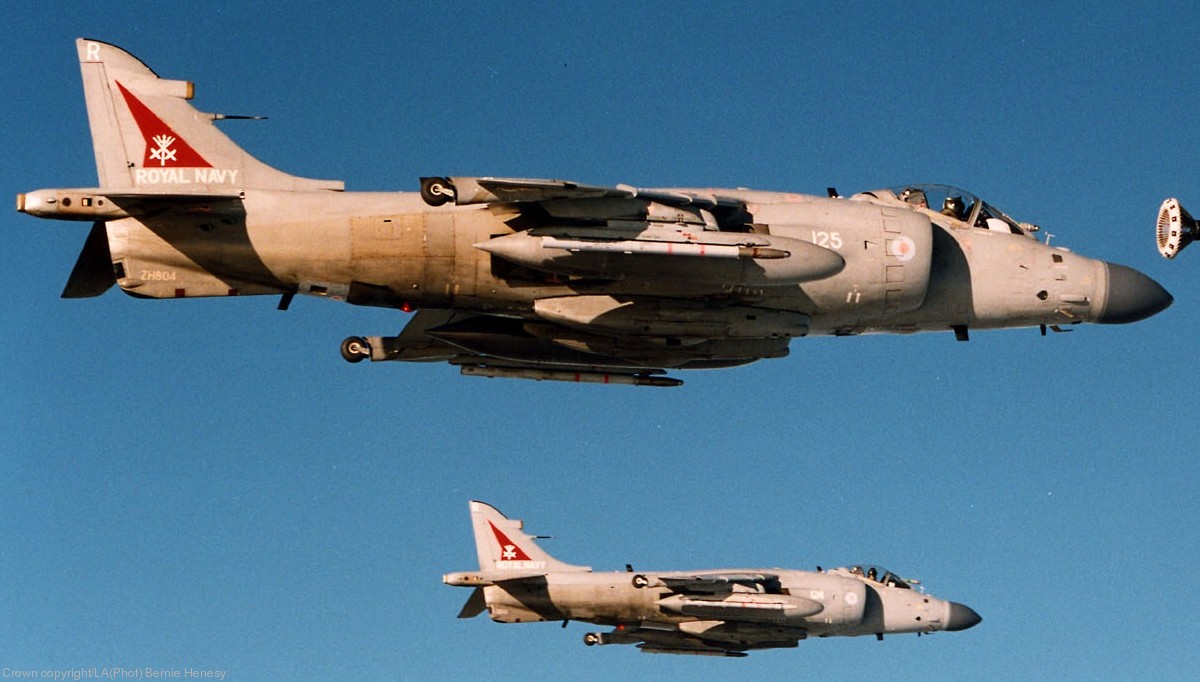 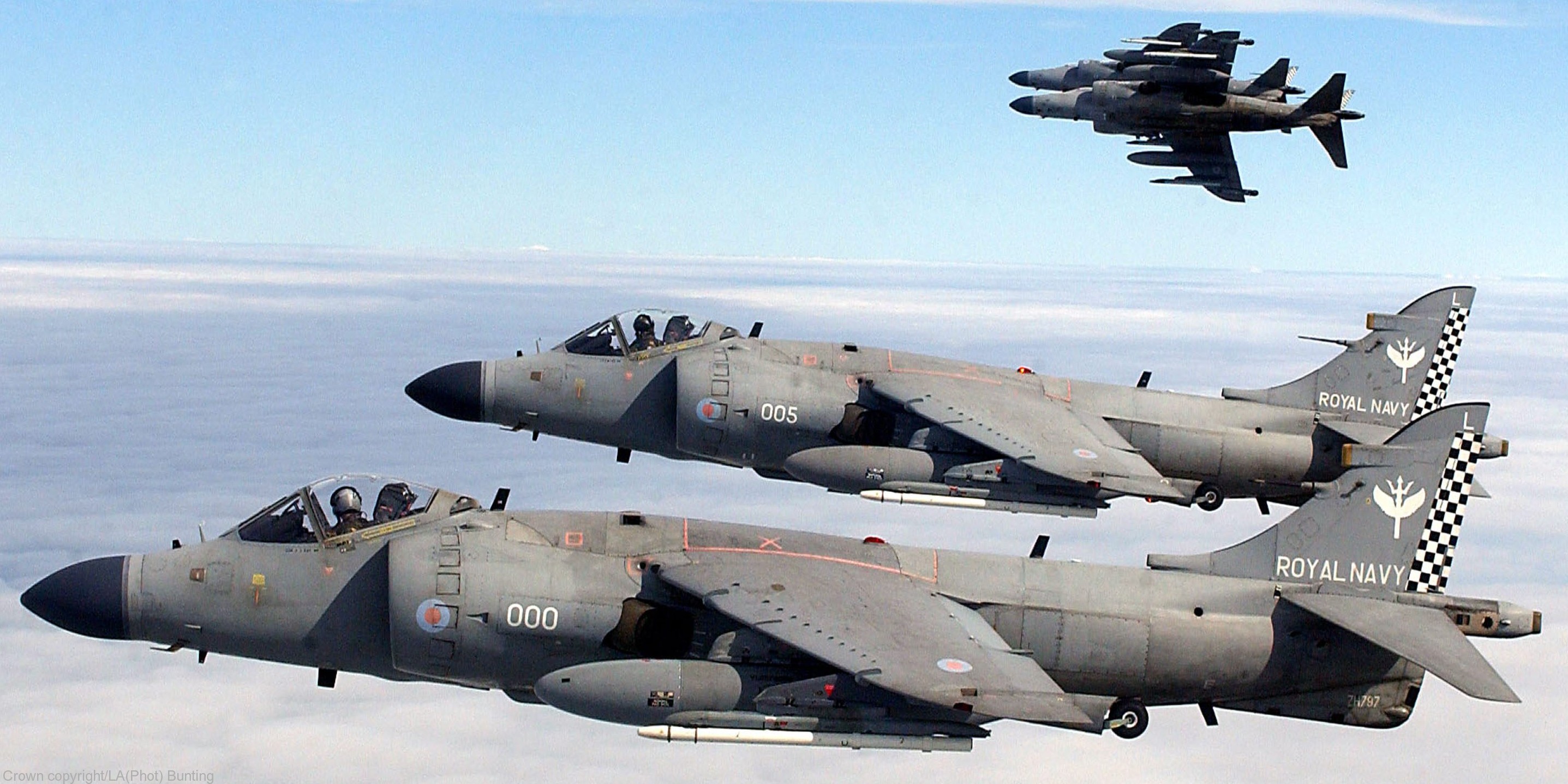  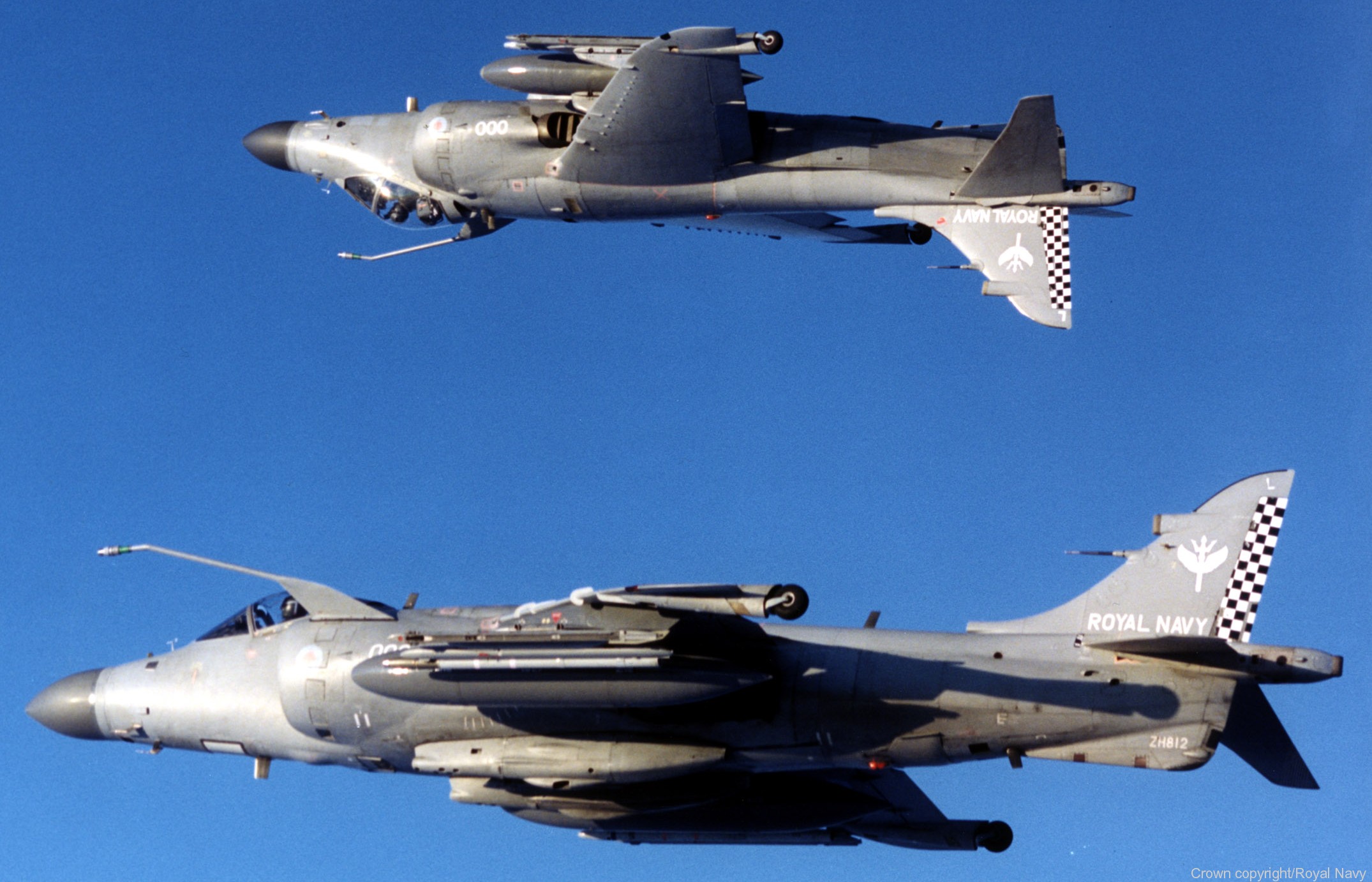 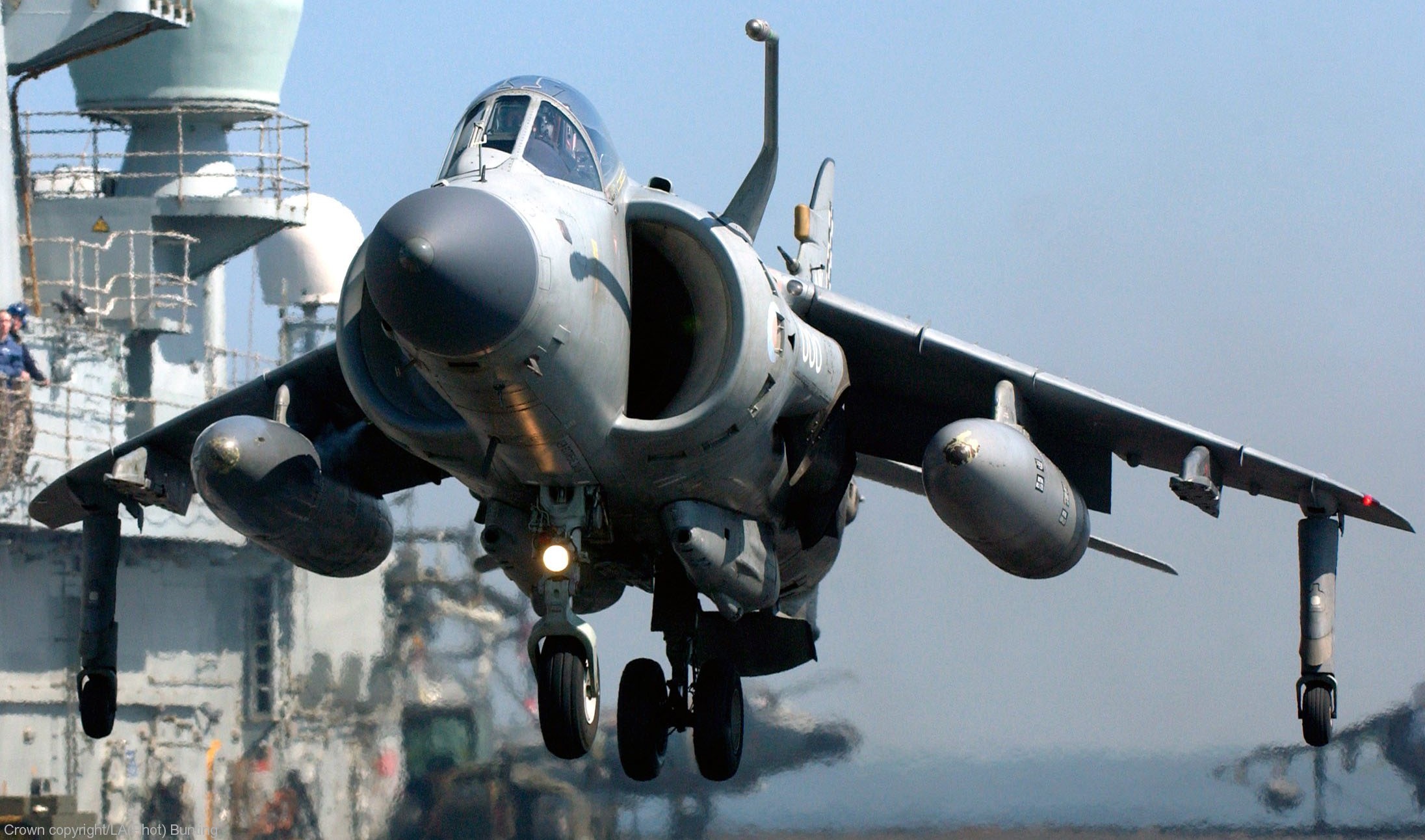 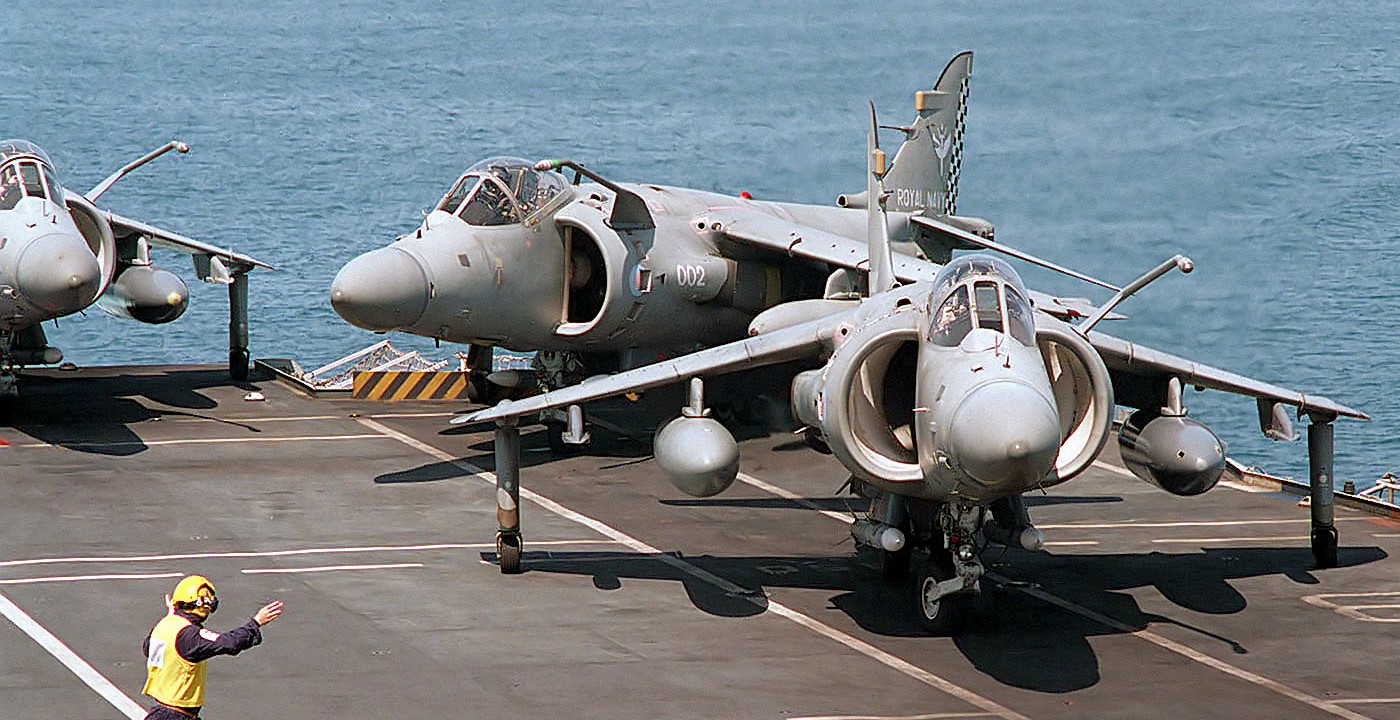 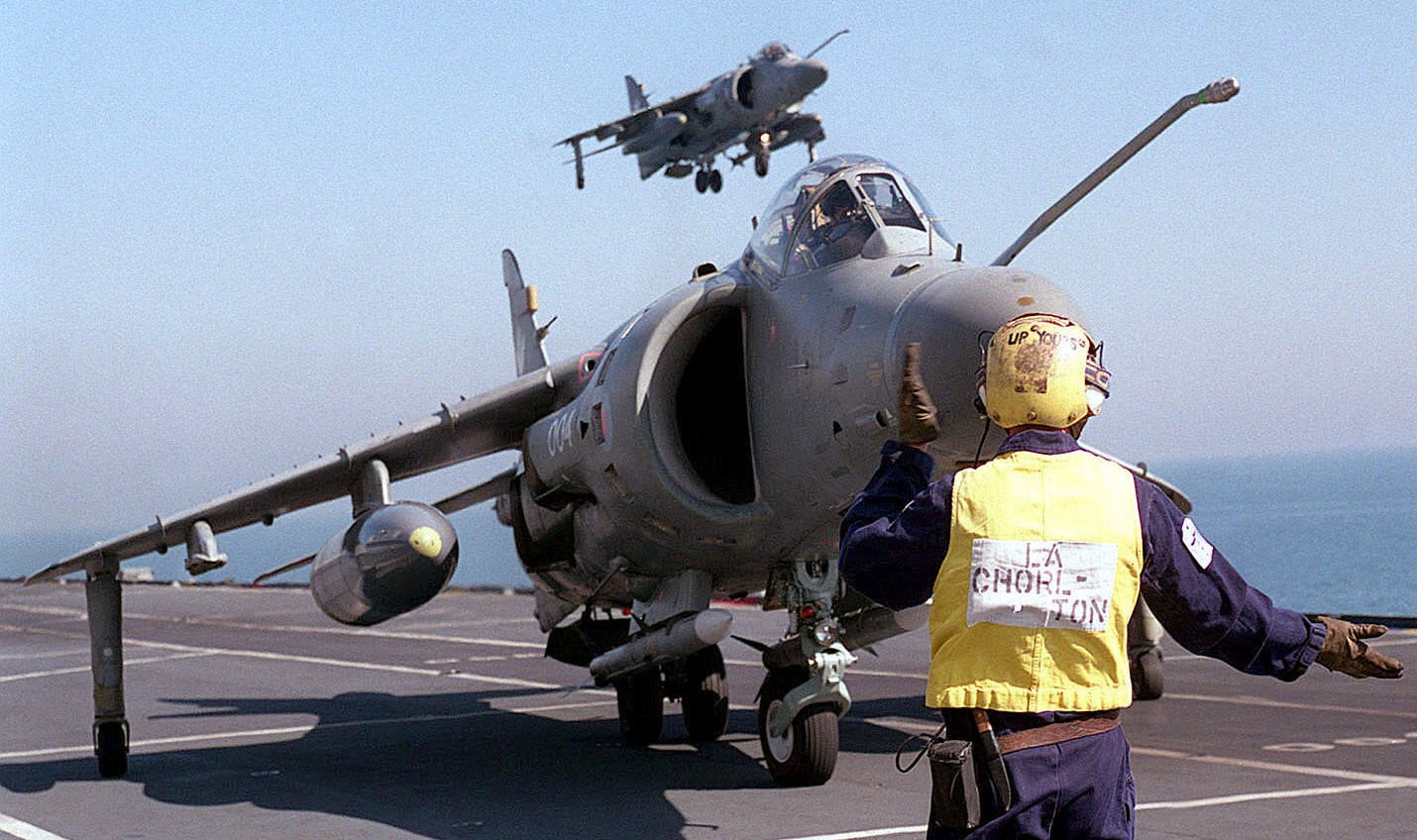 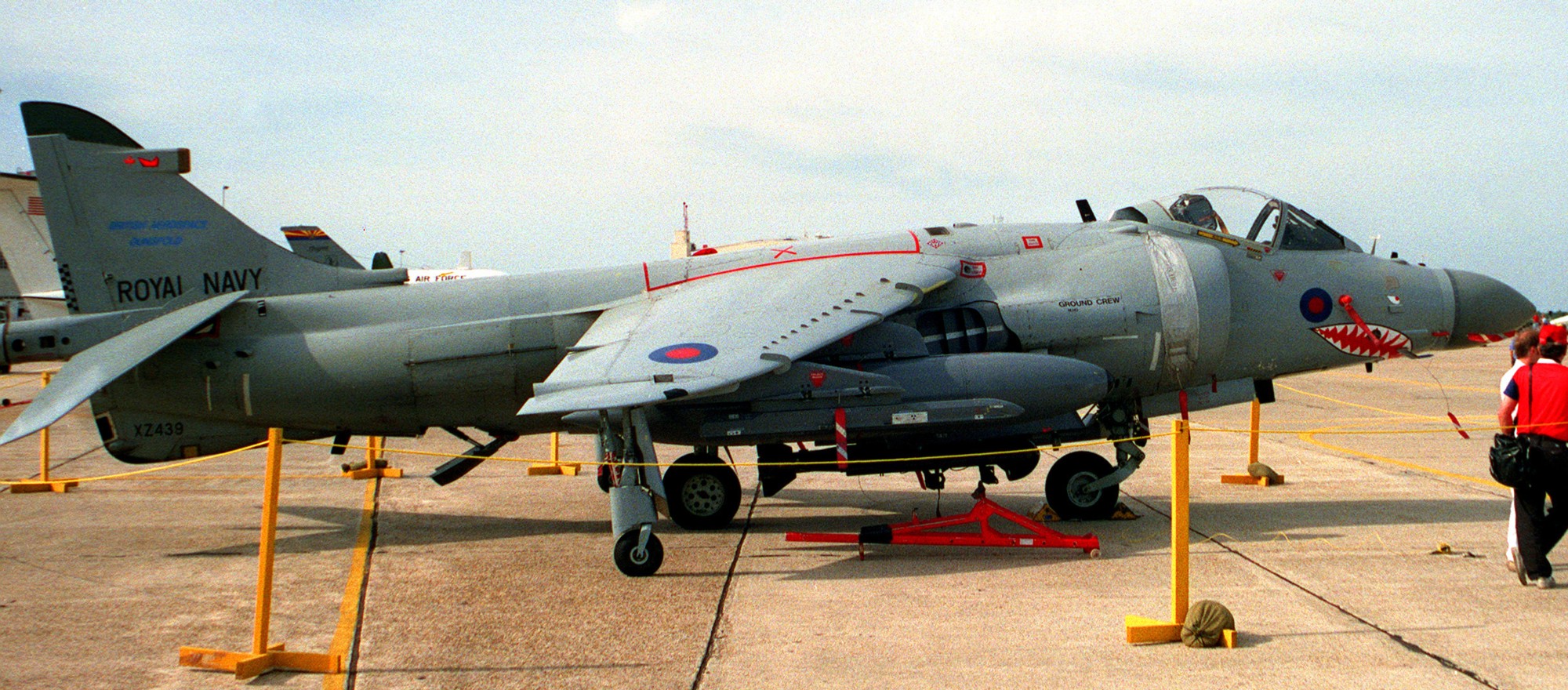 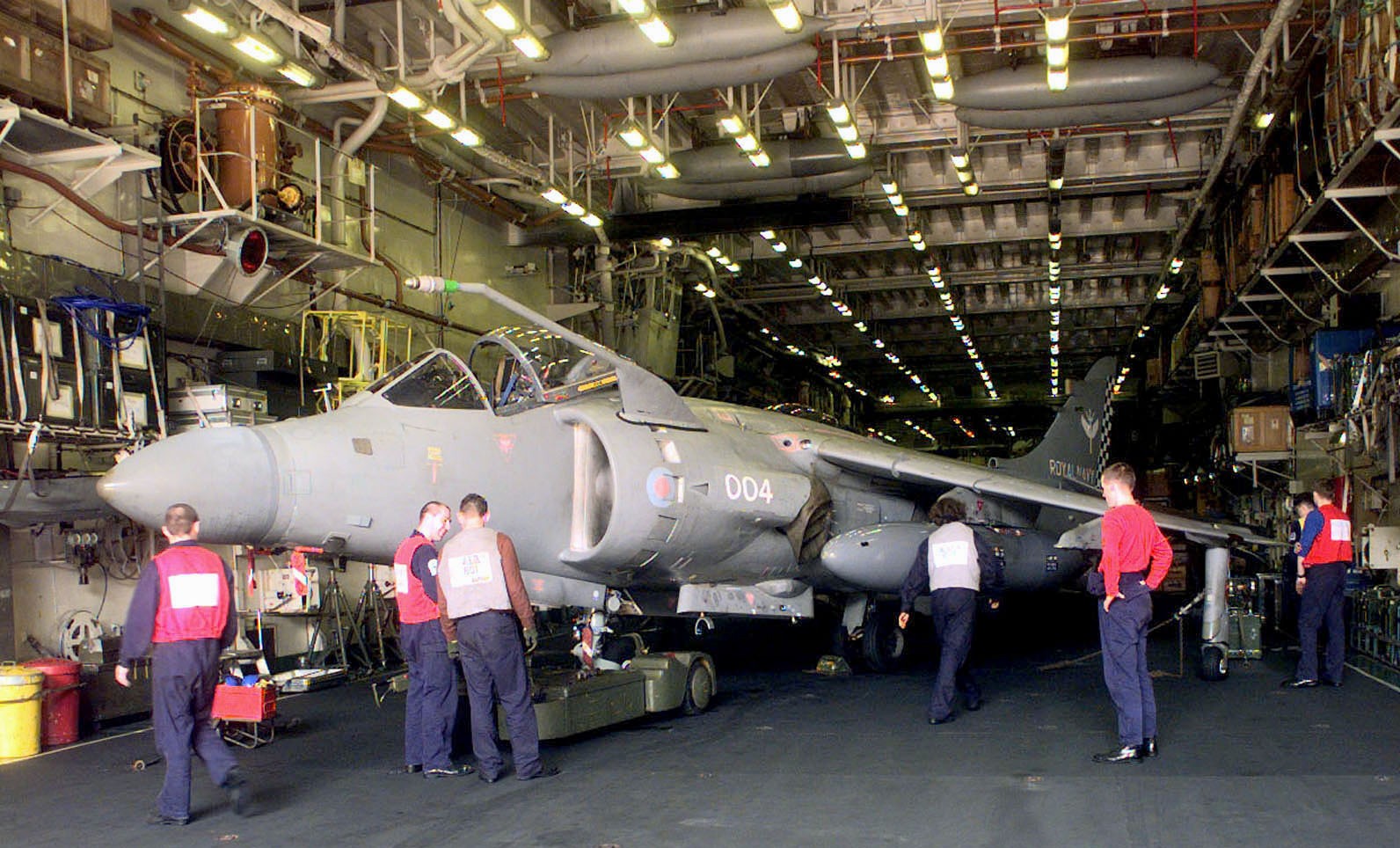 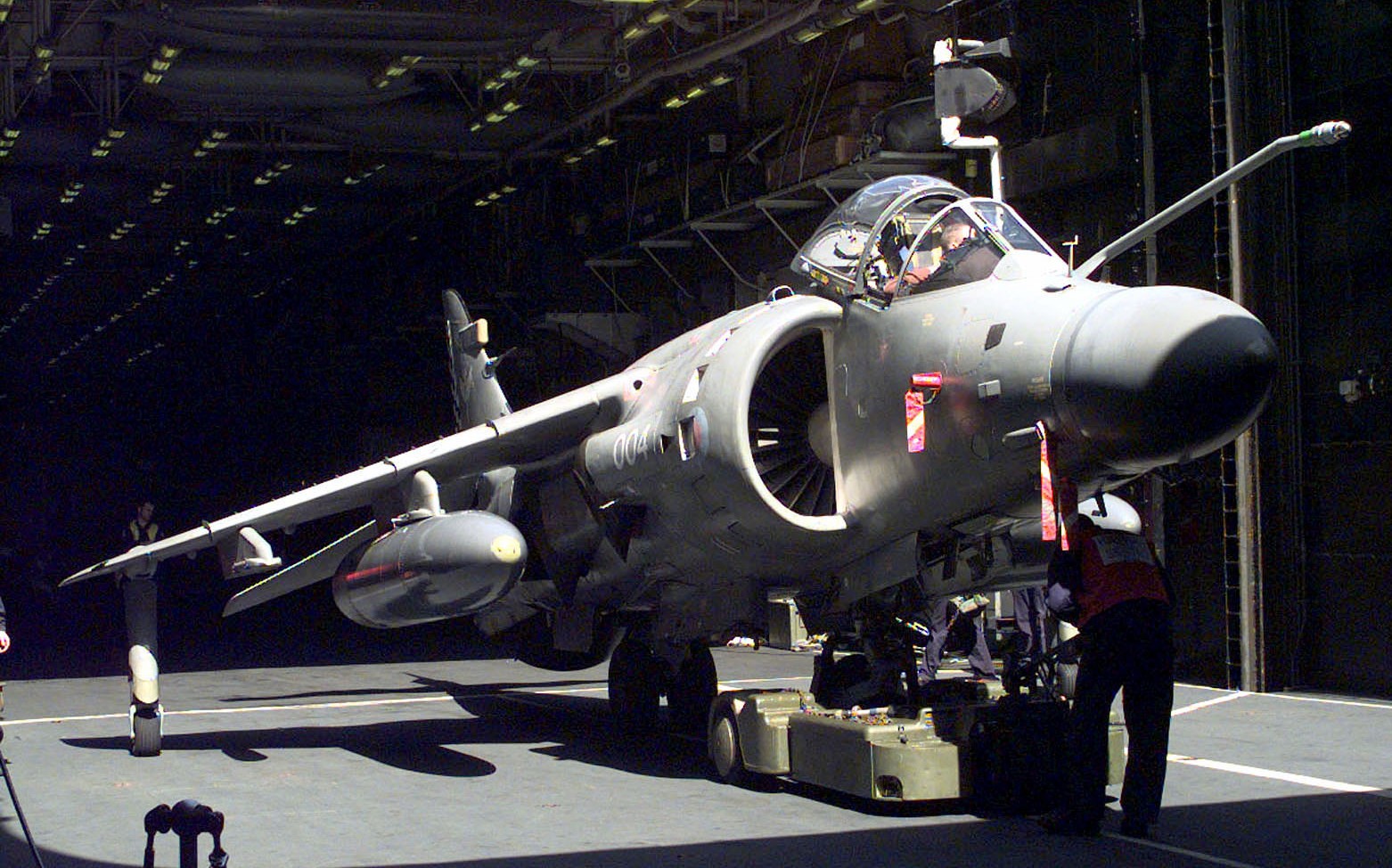 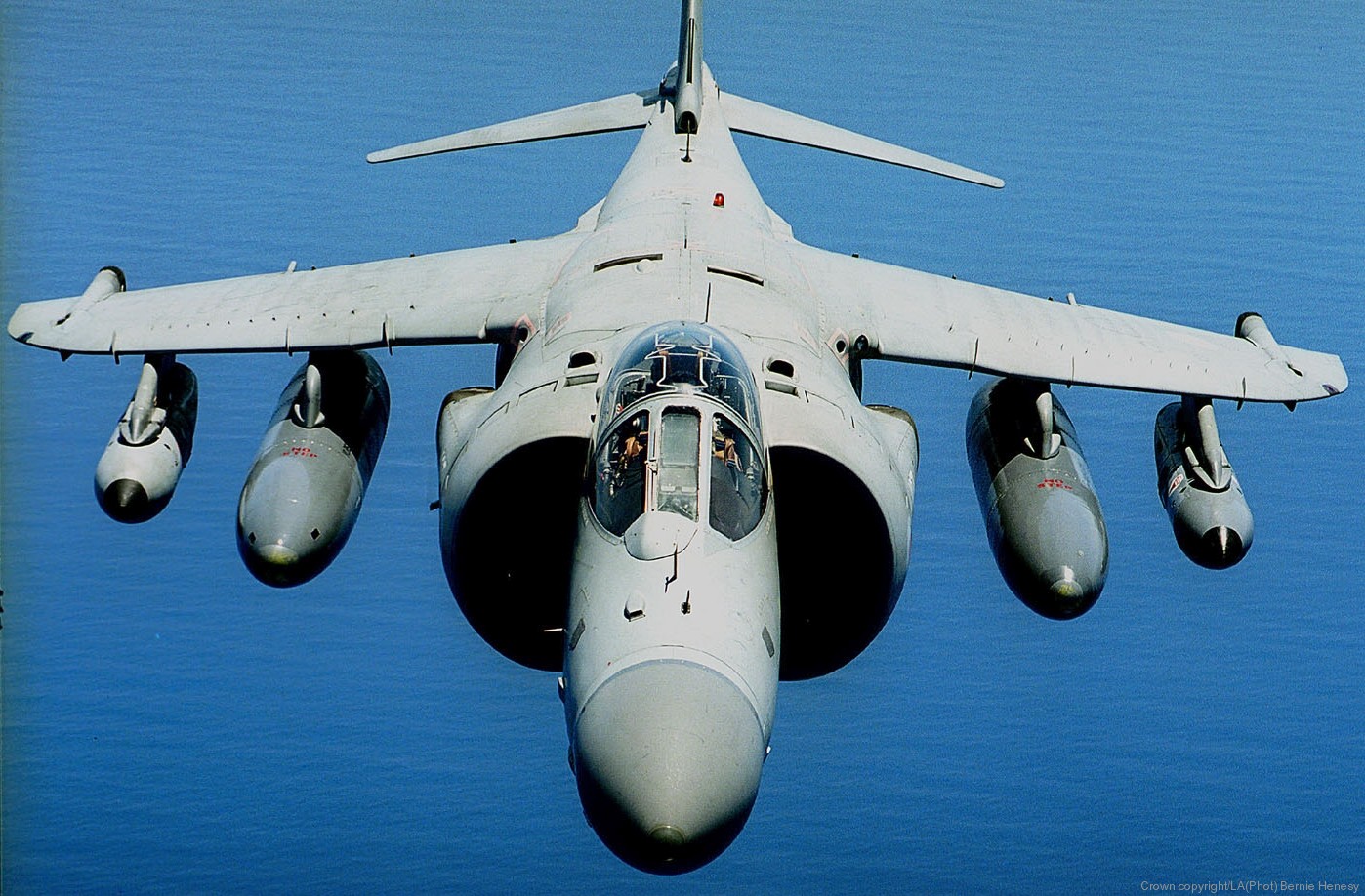 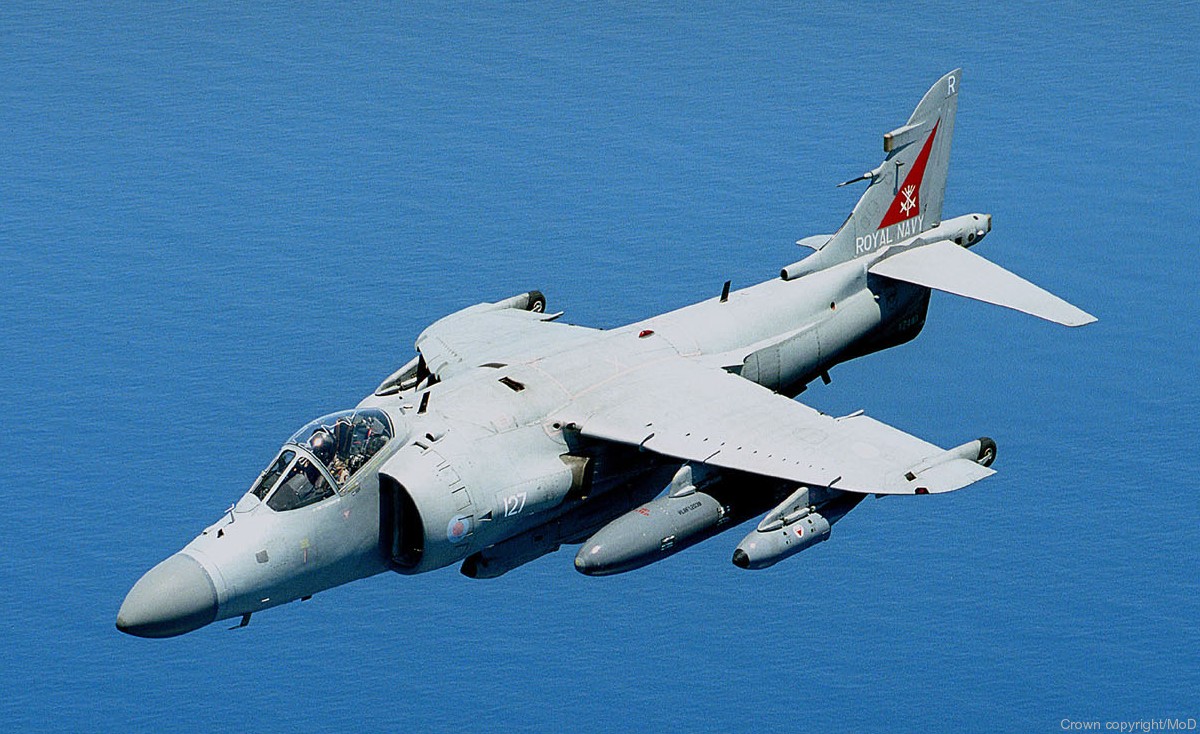 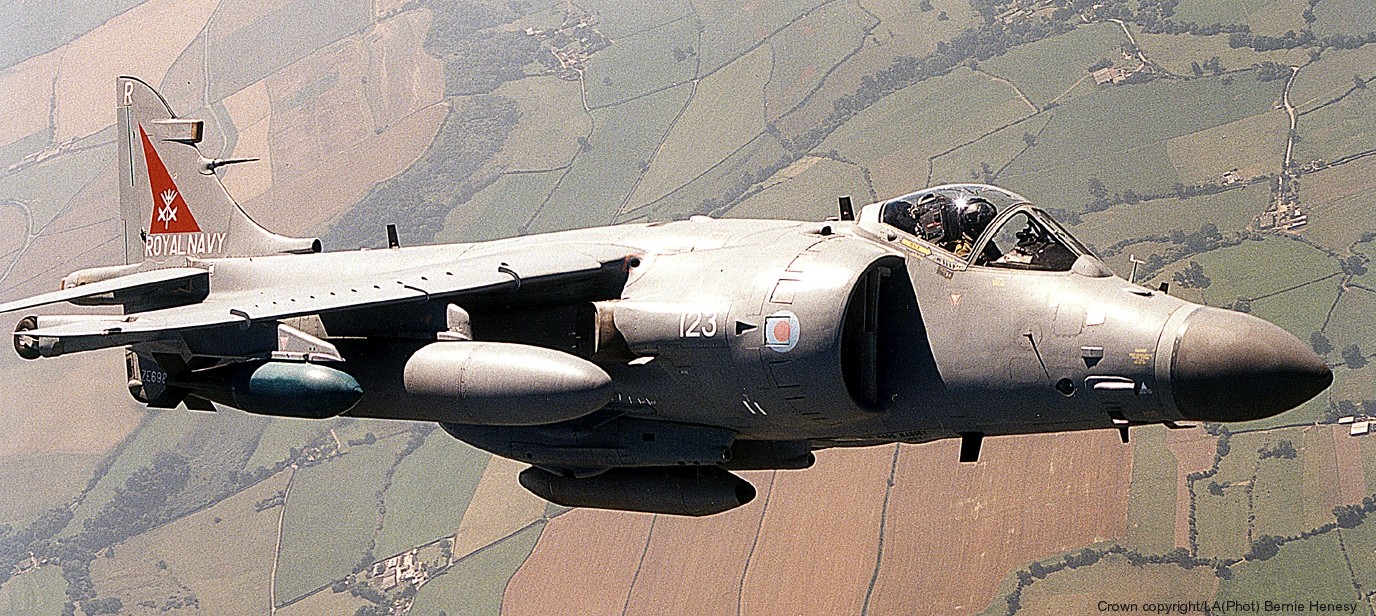 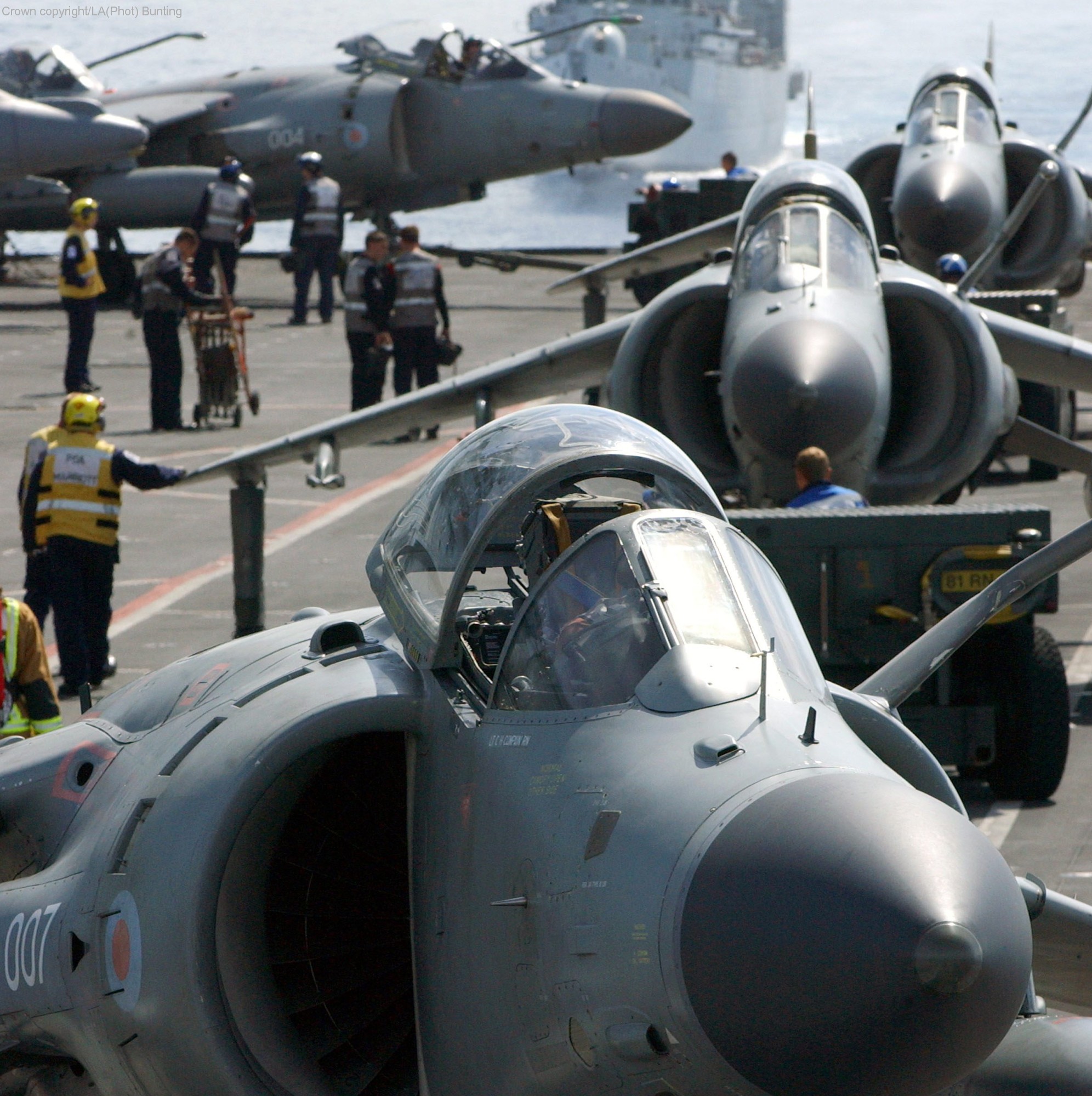 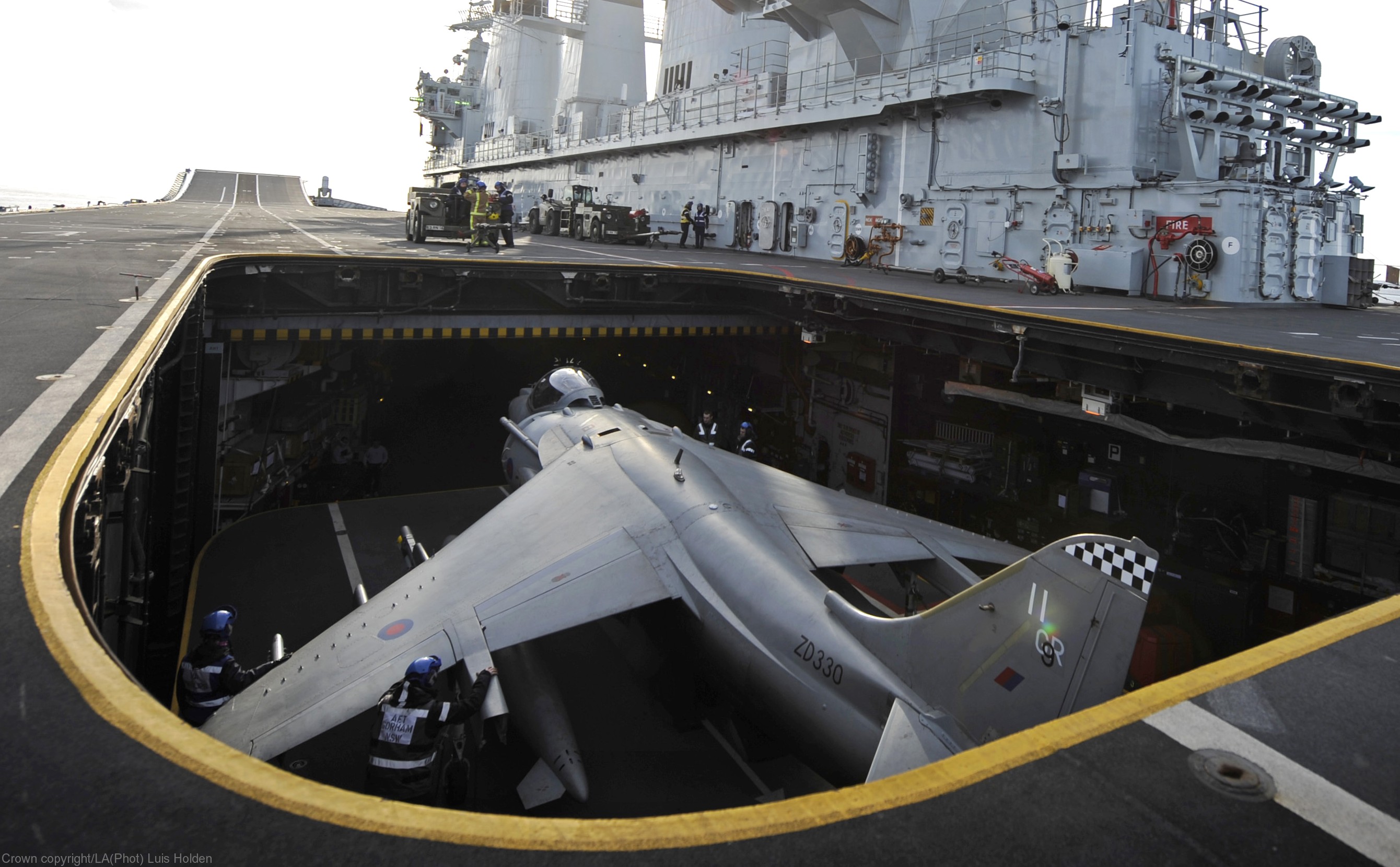 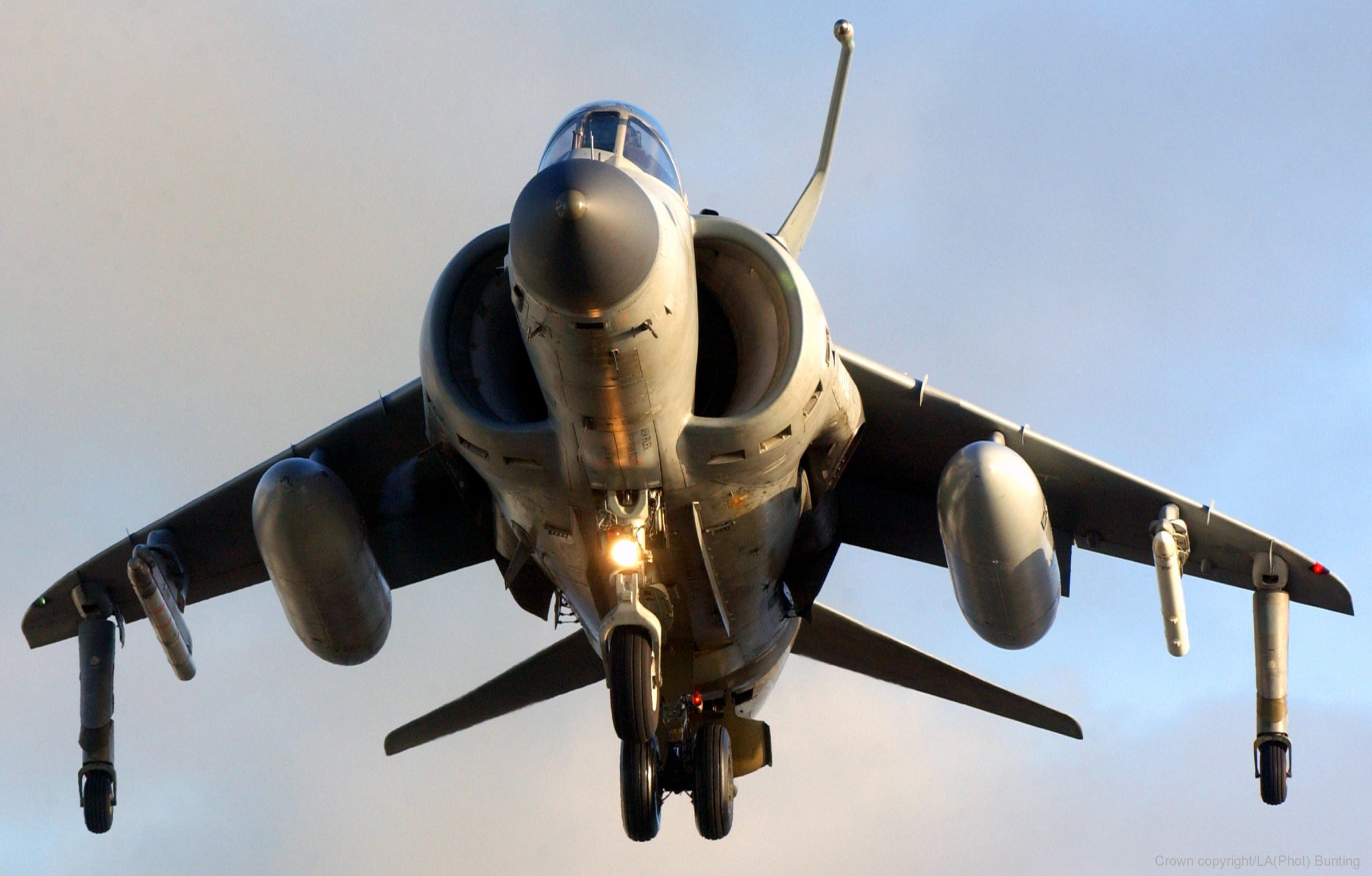 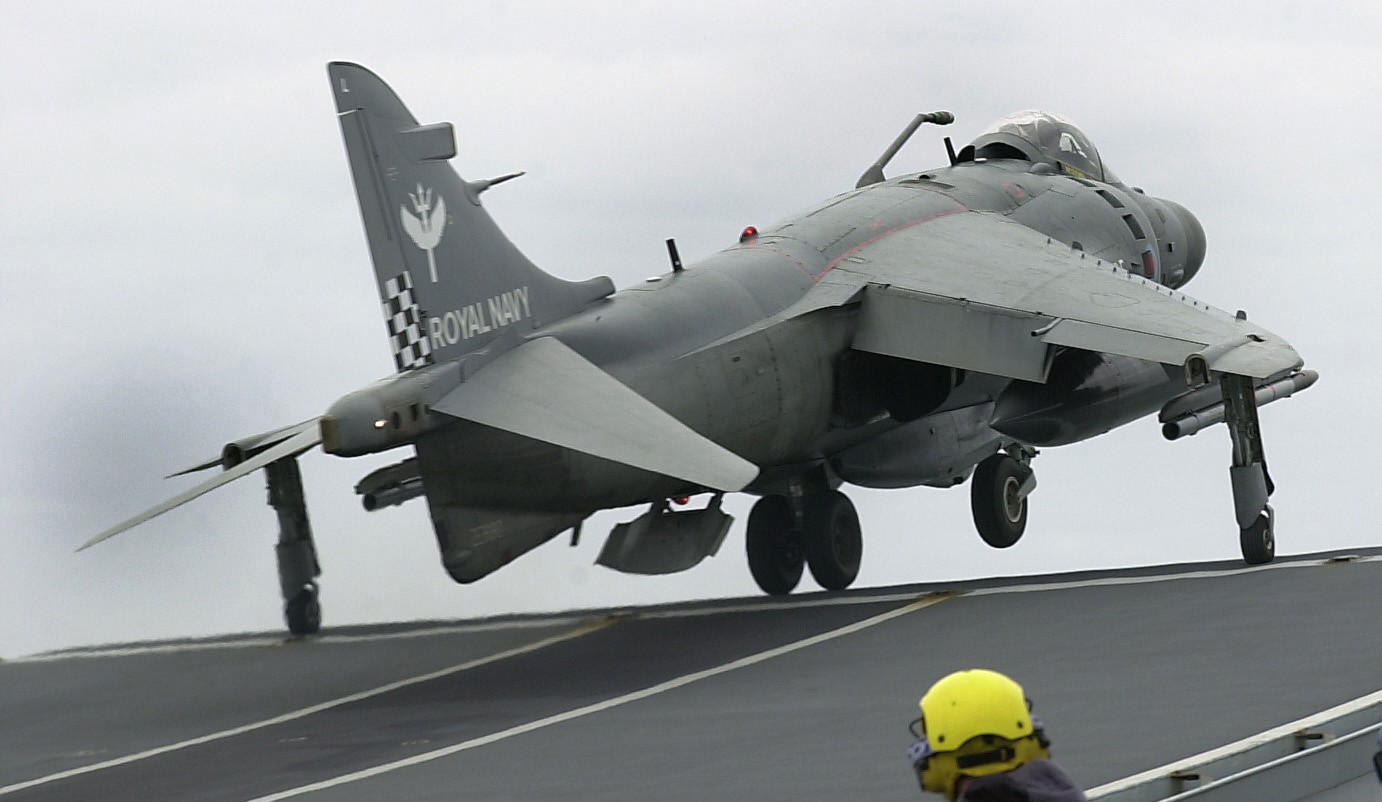 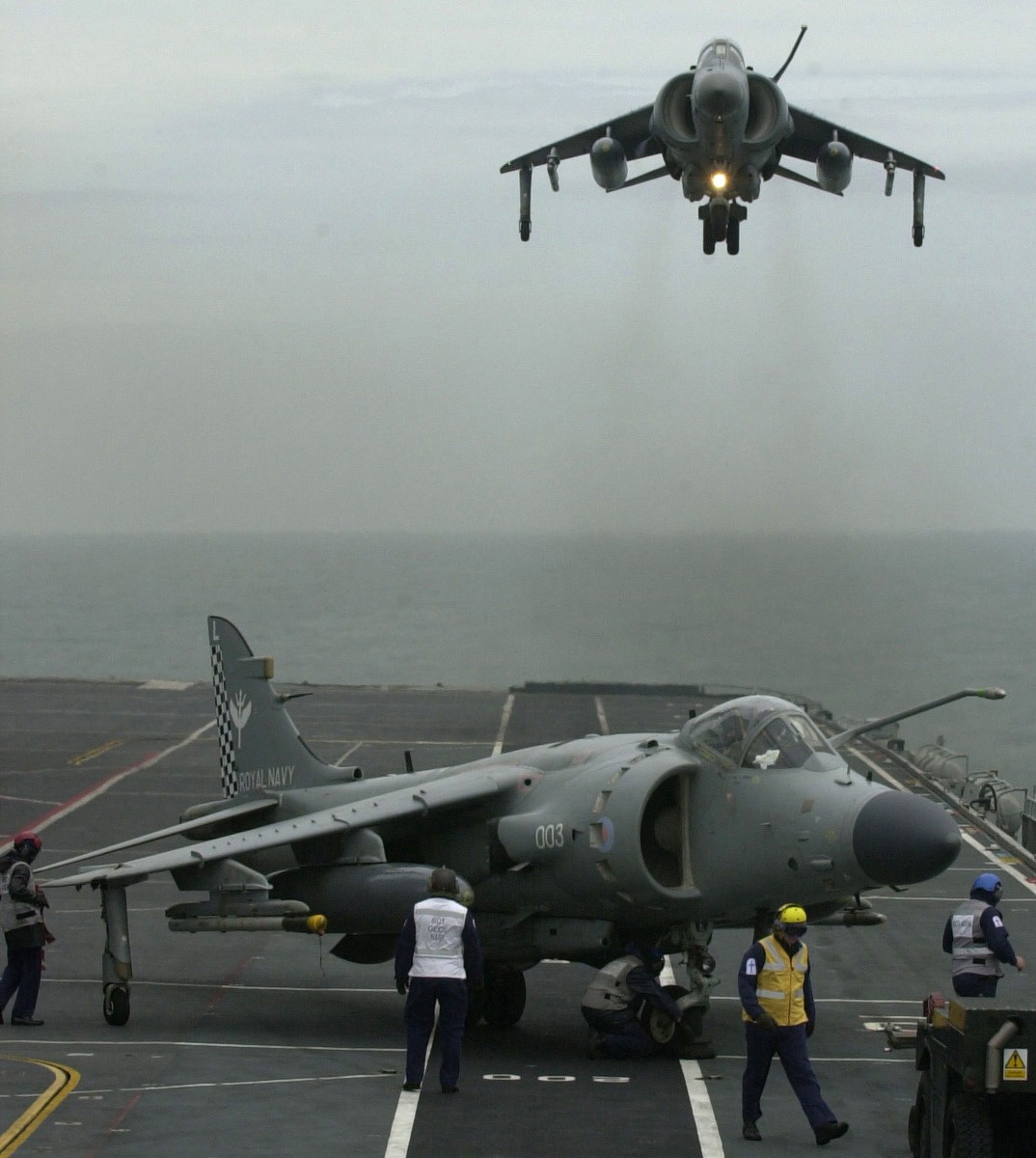 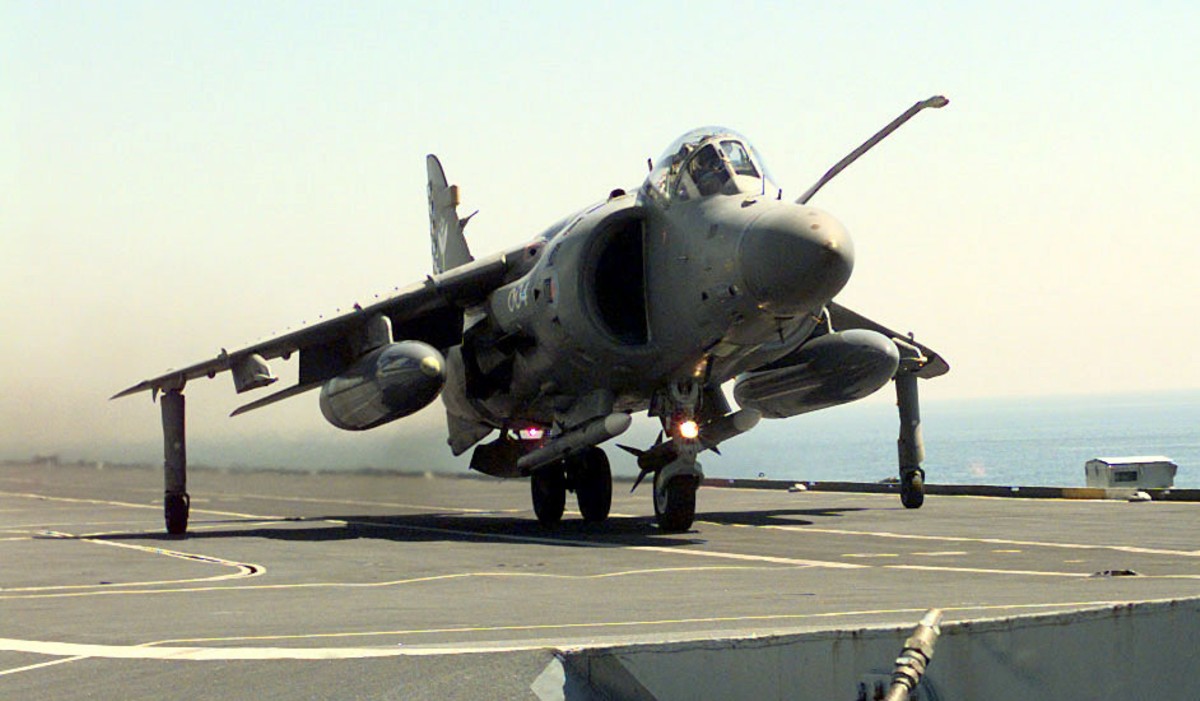 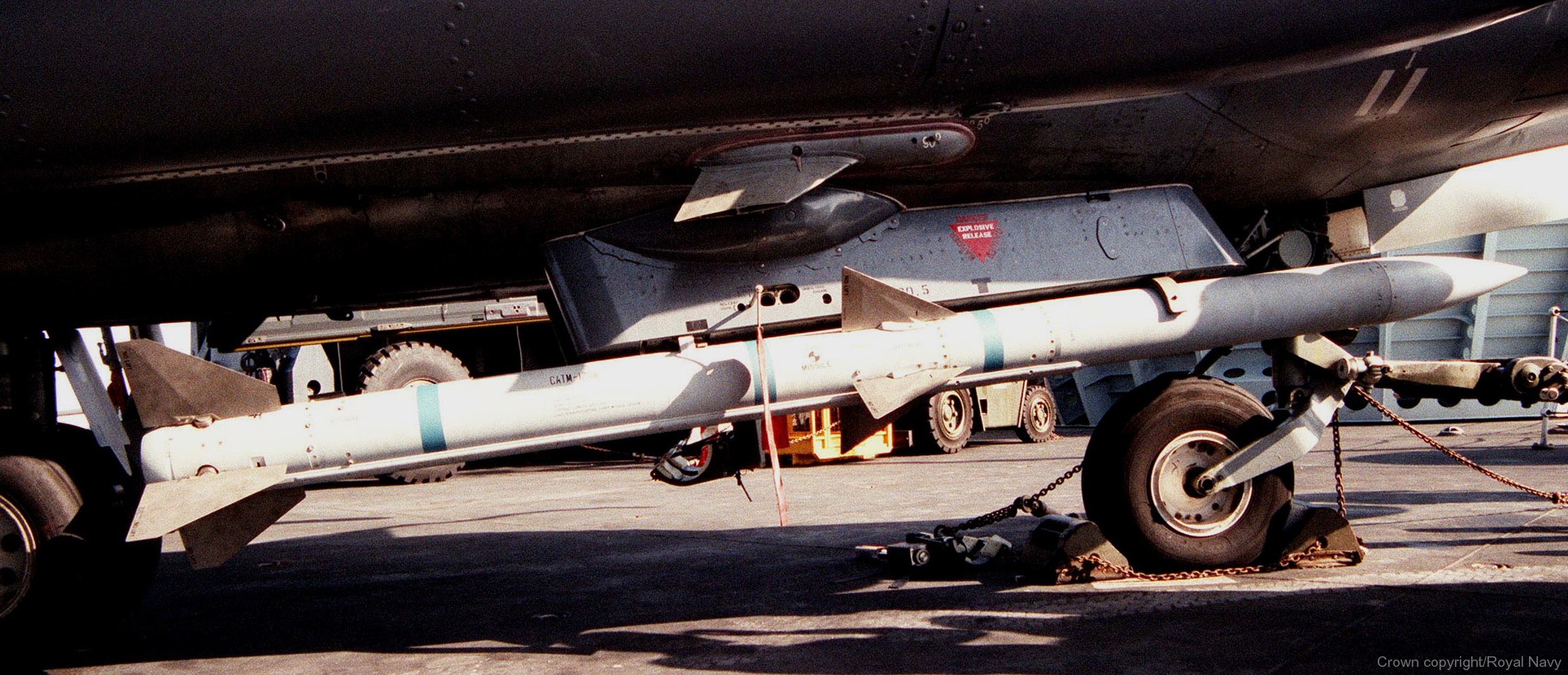 an AIM-120 AMRAAM missile on a Sea Harrier FA.2 Sea Harrier FRS.1 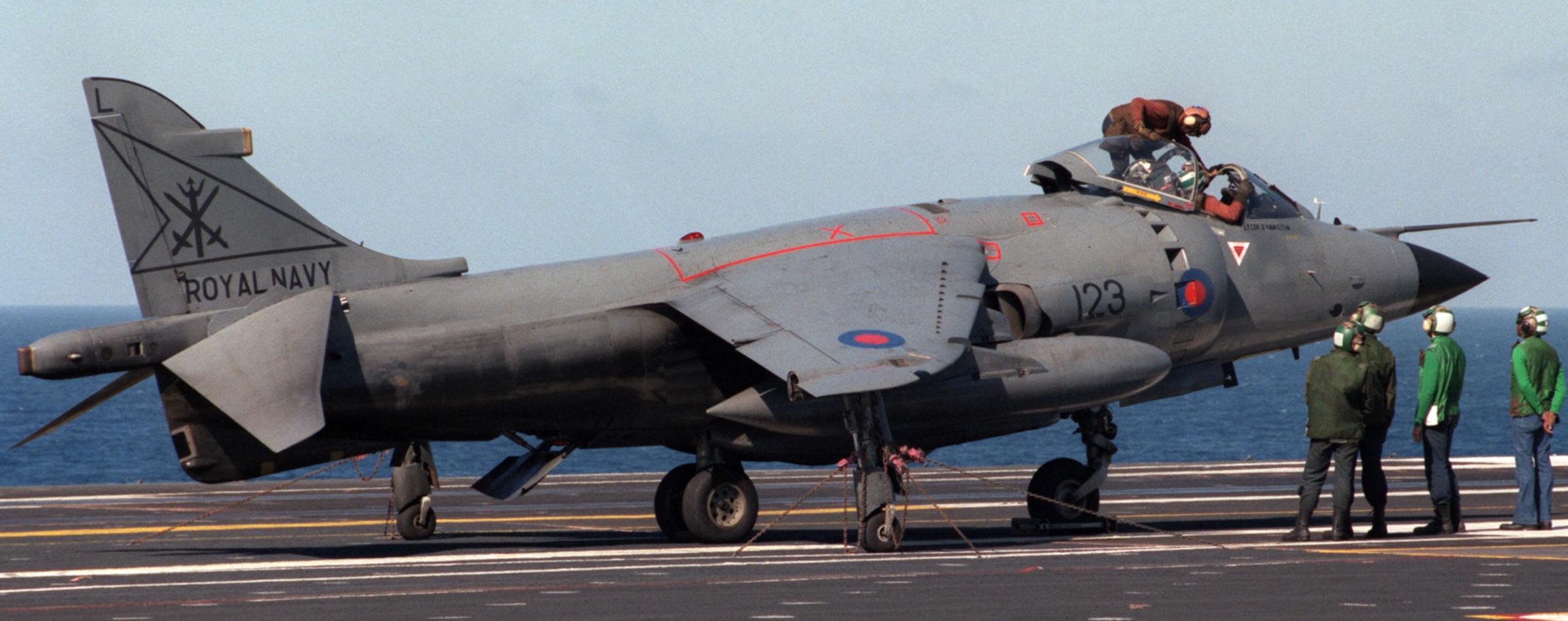 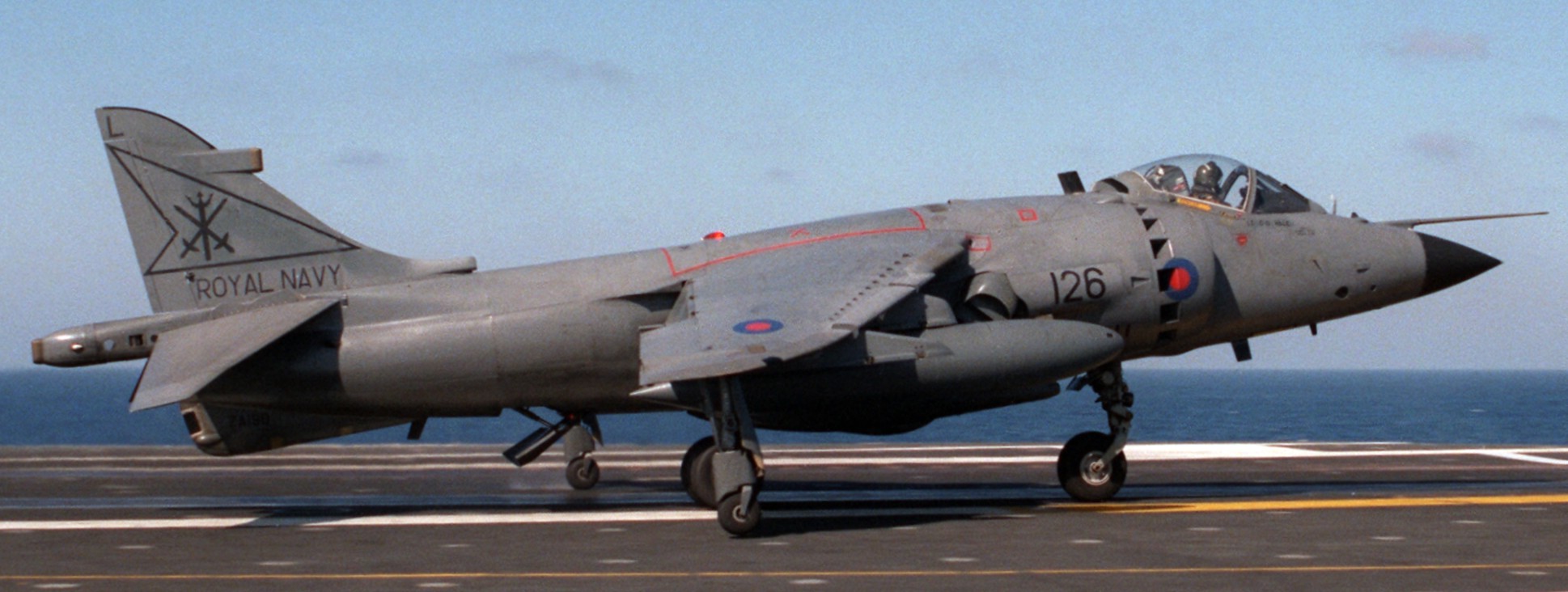 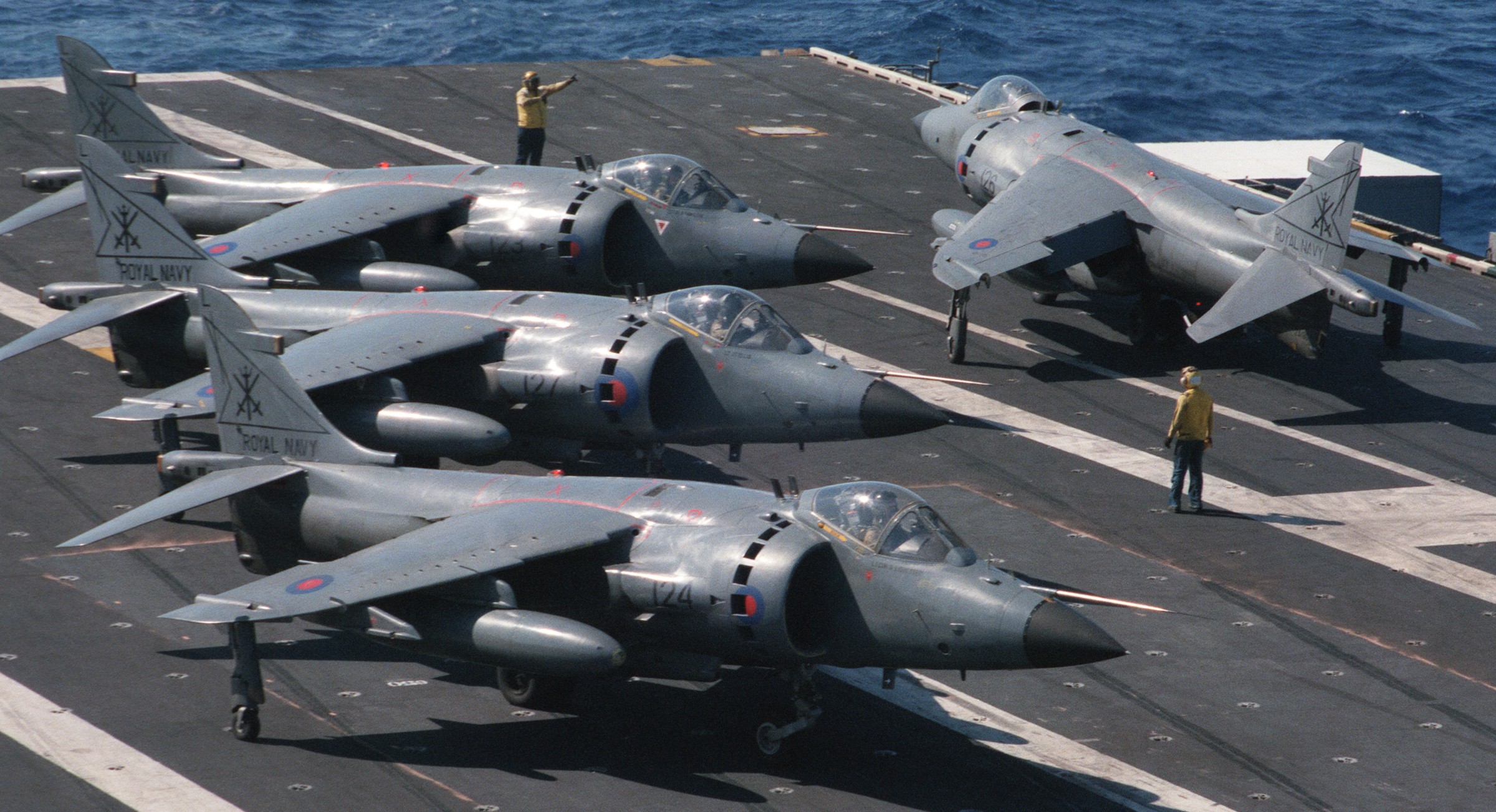 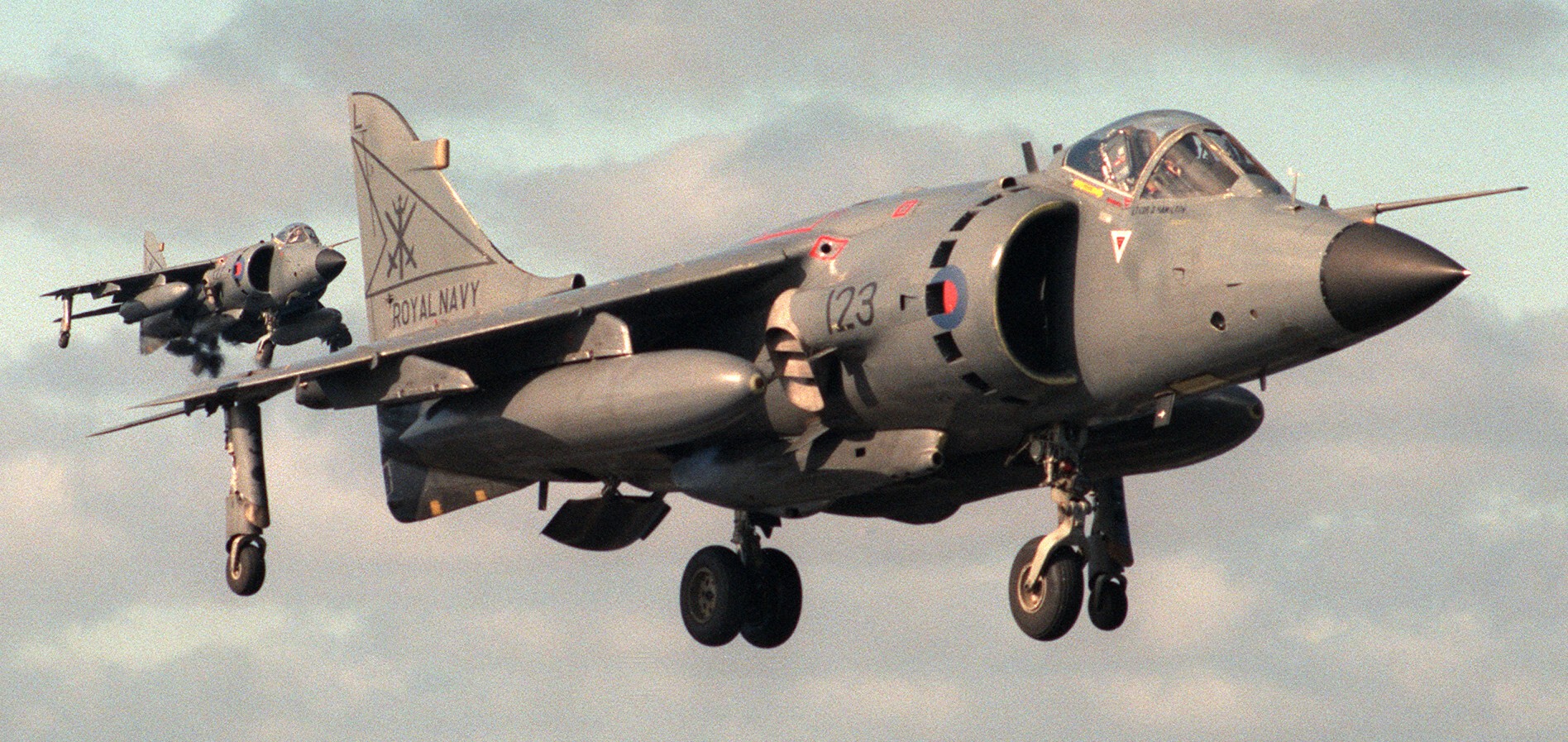 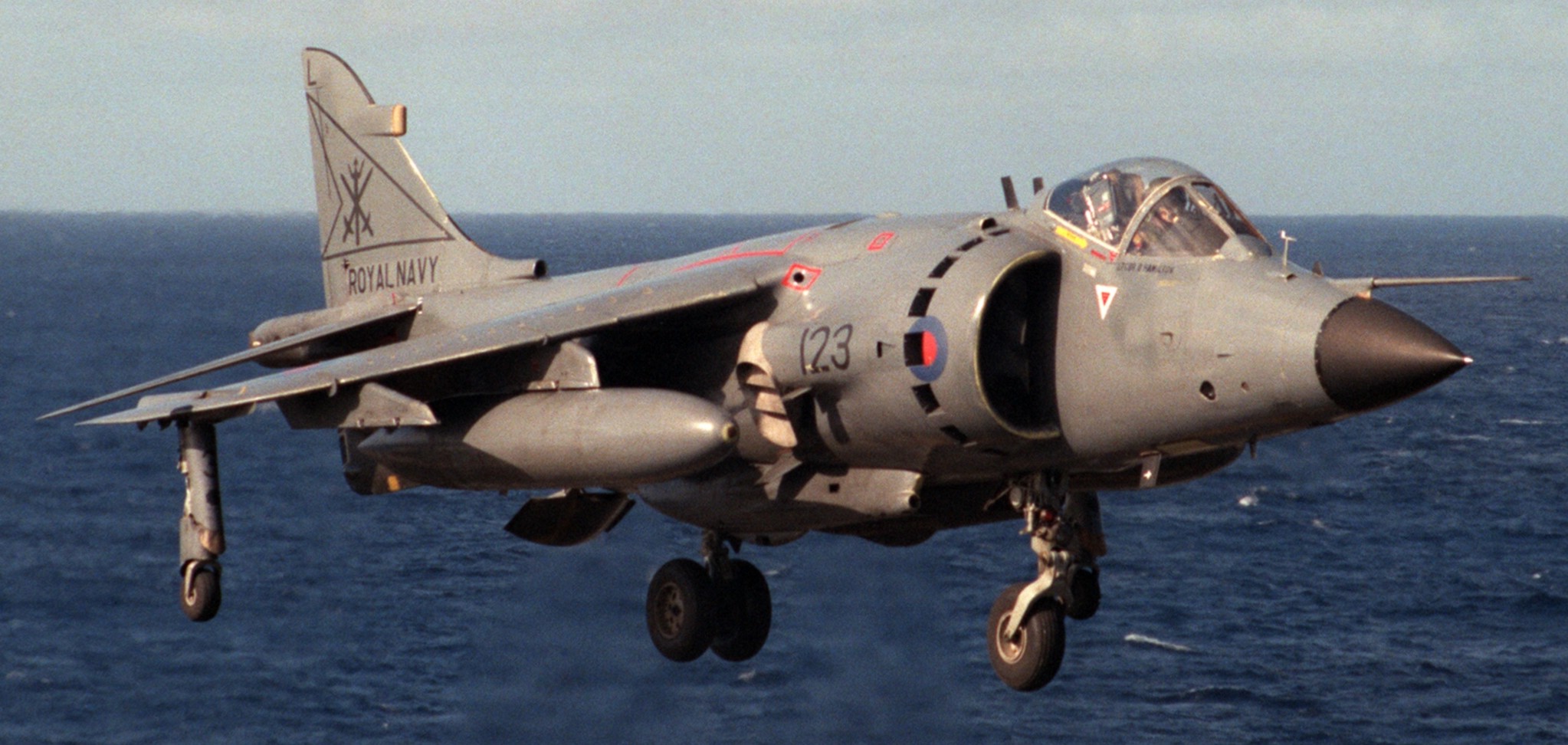 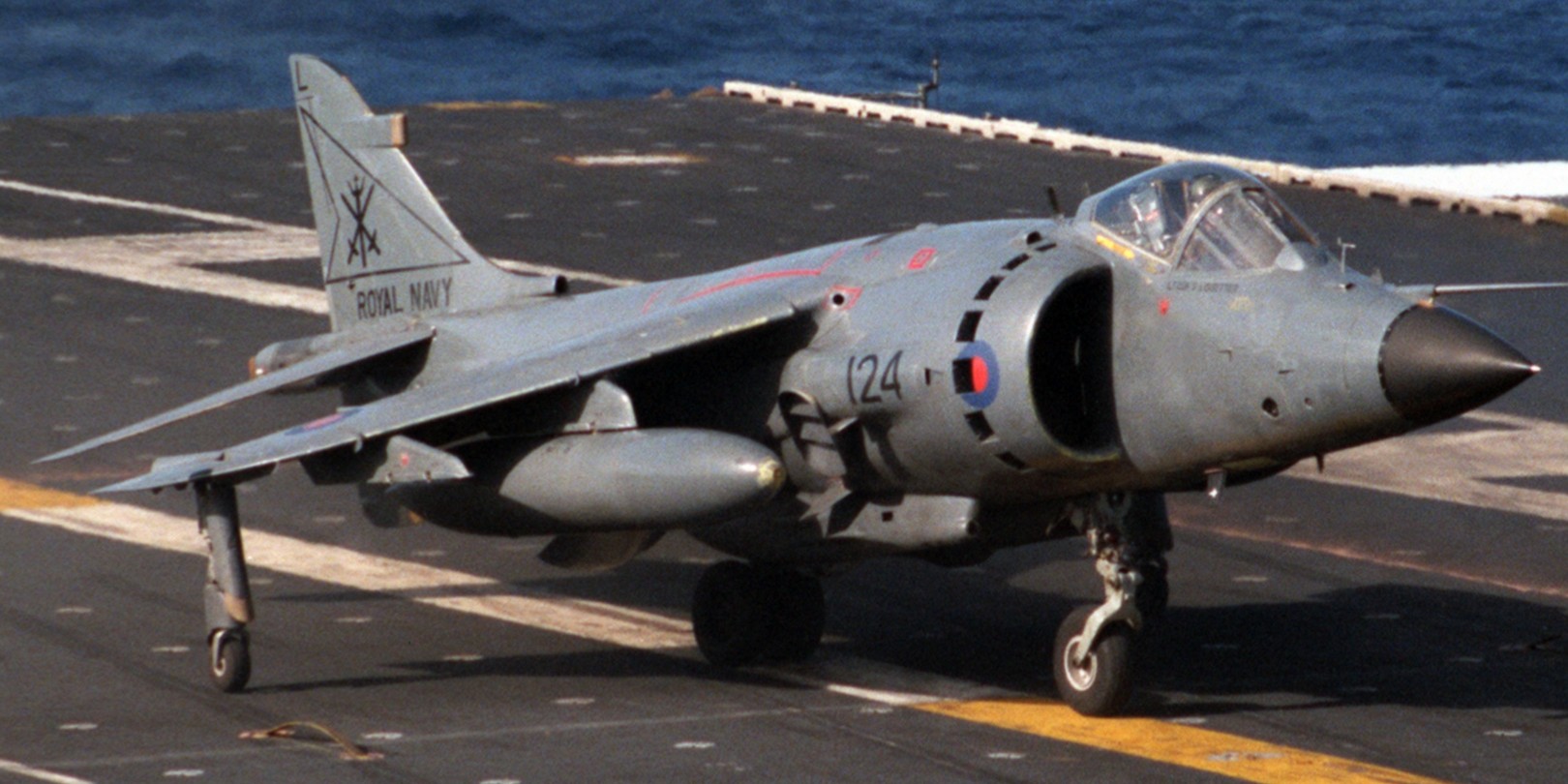 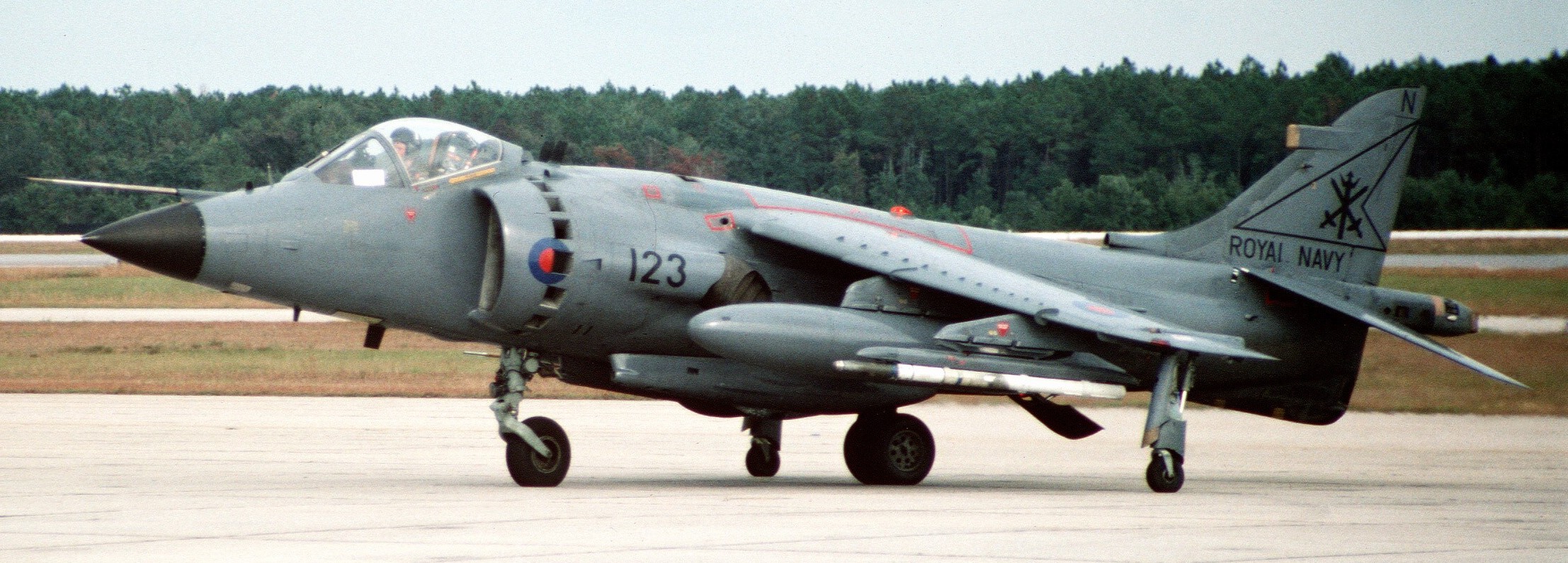 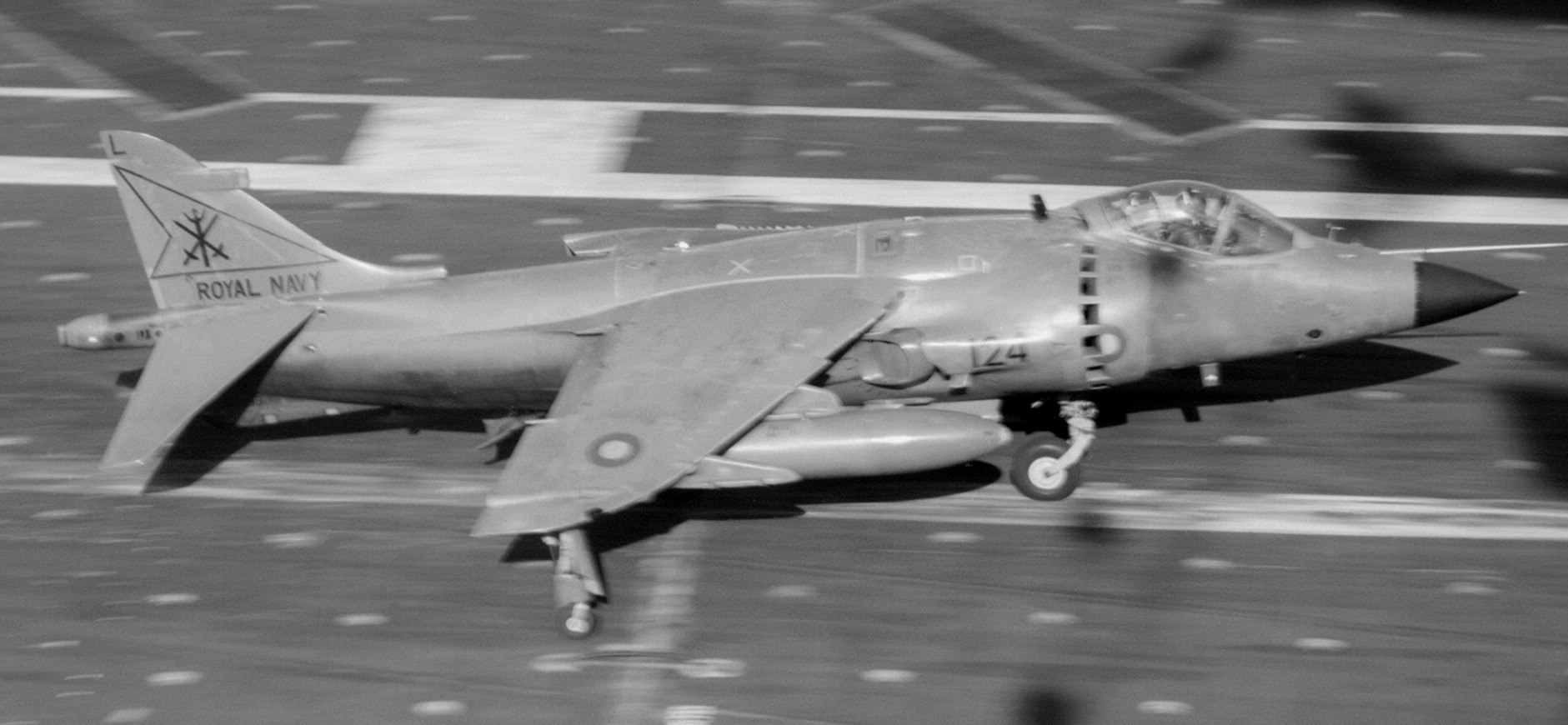 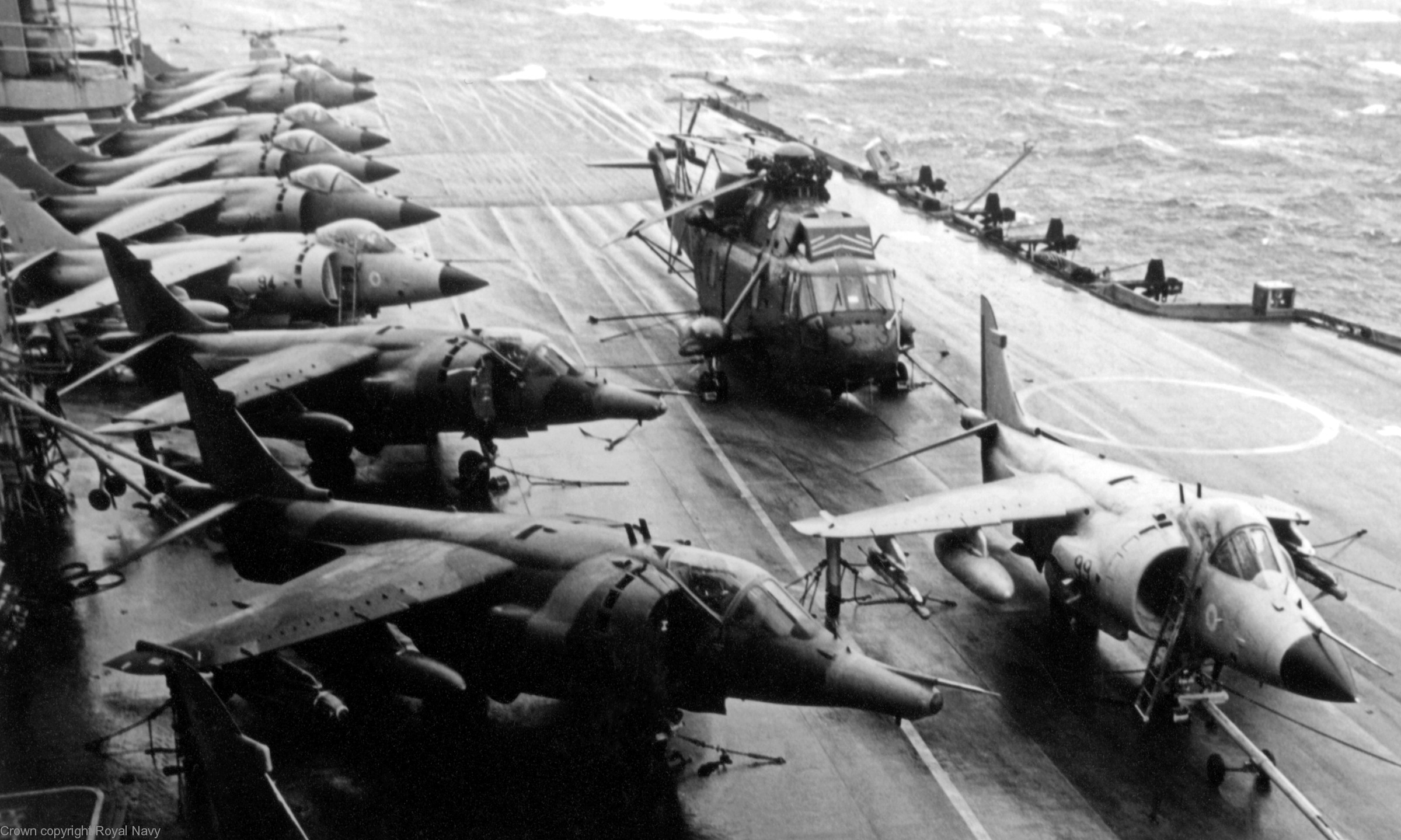 Sea Harrier FRS.1 with Royal Air Force Harriers aboard HMS Hermes (R 12) |
|
|
|
|
seaforces.org
|
Royal
Navy start page
| |